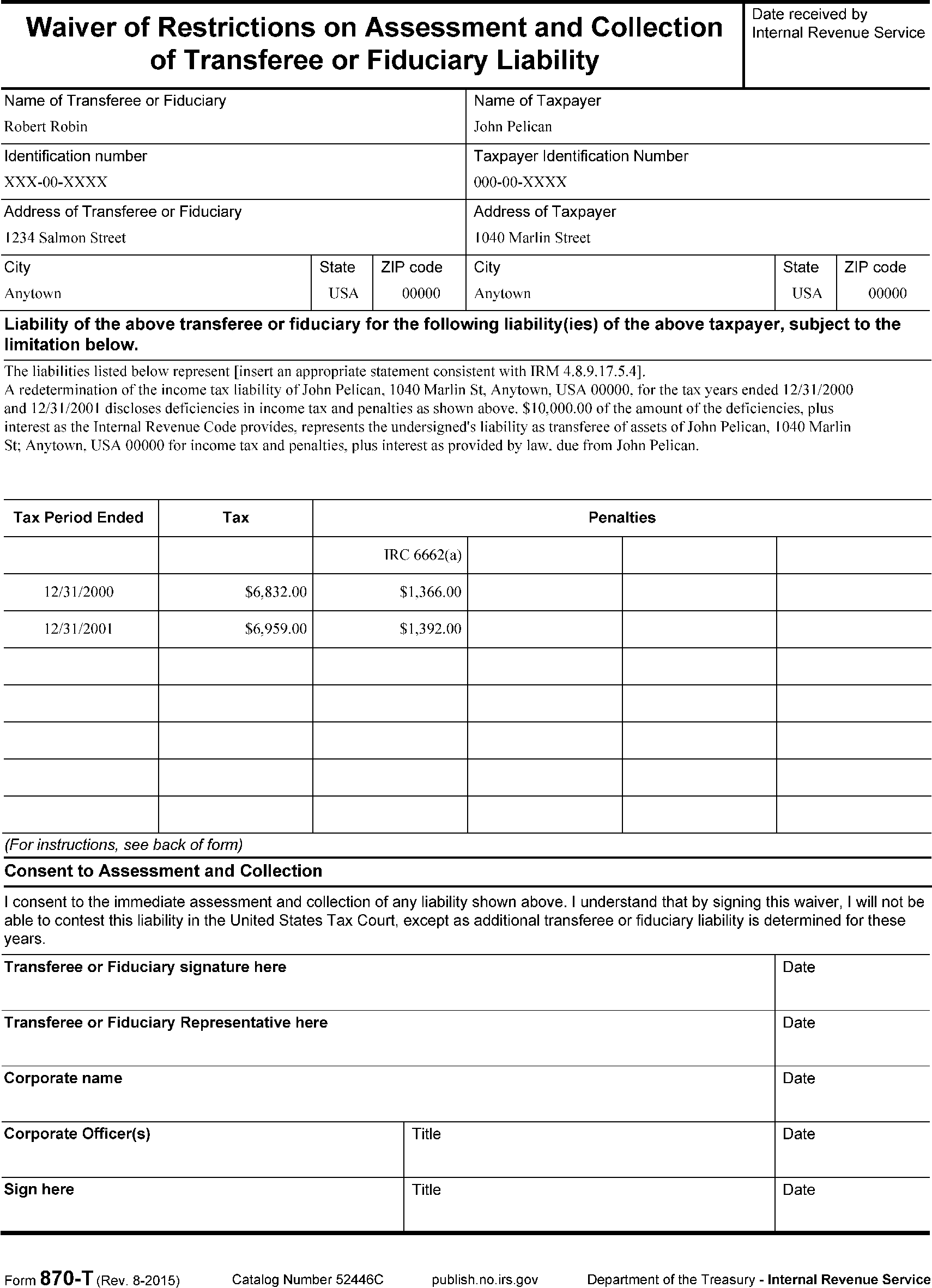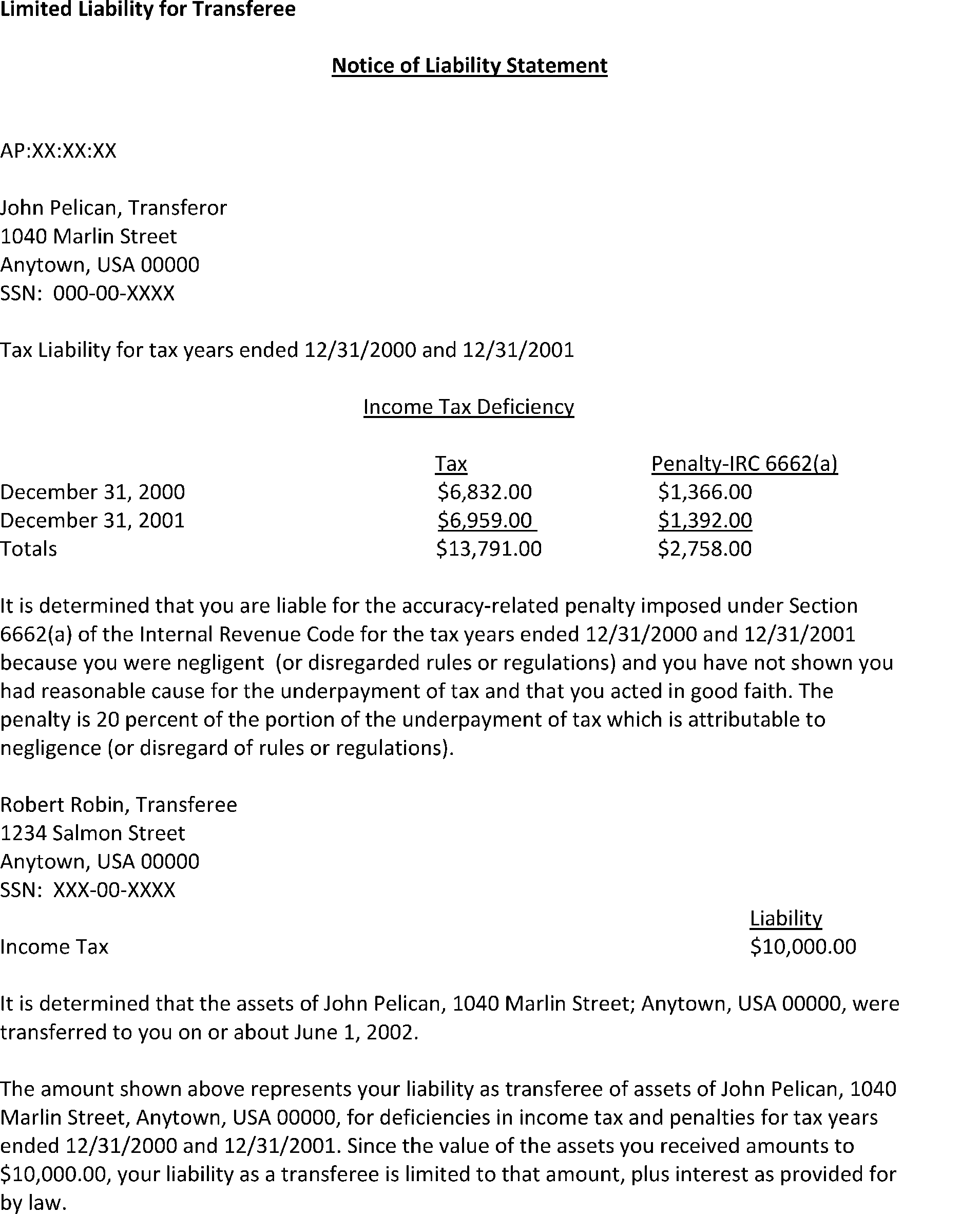- 8.7.5 Transferee and Transferor Liabilities
- 8.7.5.1 Program Scope and Objectives
- 8.7.5.1.1 Background
- 8.7.5.1.2 Authority
- 8.7.5.1.3 Responsibilities
- 8.7.5.1.4 Program Reports
- 8.7.5.1.5 Terms and Acronyms
- 8.7.5.1.6 Related Resources
- 8.7.5.2 Introduction to Working Transferee Cases in Appeals
- 8.7.5.3 ATE Case Receipt Procedures
- 8.7.5.4 Consents and Period of Limitations on Transferee Cases
- 8.7.5.5 Settlement Computations in Transferee Cases
- 8.7.5.5.1 How to Prepare the Form 3610
- 8.7.5.5.2 Interest Computations in Transferee Cases
- 8.7.5.5.3 Form 1296, Assessment Against Transferee or Fiduciary
- 8.7.5.5.4 Statements of Account in Transferee Cases
- 8.7.5.6 Modification of Agreement Forms in Transferee Cases
- 8.7.5.7 Closing an Agreed Transferee Case
- 8.7.5.8 Issuing a Notice of Transferee or Fiduciary Liability on an Unagreed Transferee Case
- 8.7.5.8.1 Identification of Tax Years in Transferee Notice
- 8.7.5.8.2 Letter 3424 - Notice of Transferee or Fiduciary Liability
- 8.7.5.8.3 Notice of Liability Statement
- 8.7.5.8.4 Explanations of Adjustments and Computation of Tax
- 8.7.5.8.5 Waiver Needed
- 8.7.5.8.6 Transferee Assessments
- 8.7.5.9 Jurisdiction of Tax Court
- 8.7.5.10 Closing Procedures for Transferee/Transferor Cases
- Exhibit 8.7.5-1 Form 3610, Audit Statement - Transferee with Limited Liability - One Year
- Exhibit 8.7.5-2 Form 3610, Audit Statement - Transferee with Limited Liability - Multiple Years
- Exhibit 8.7.5-3 Sample Form 1296, Assessment Against Transferee or Fiduciary
- Exhibit 8.7.5-4 Attachment to Form 1296 - Transferee with Limited Liability – Multiple Years
- Exhibit 8.7.5-5 Selectable Opening Paragraphs for Letter 3424
- Exhibit 8.7.5-6 Transferee Statements Attached to Letters
- Exhibit 8.7.5-7 Full Liability Transferee Notice
- Exhibit 8.7.5-8 Limited Liability for Transferee- Notice Letter, Form 870-T, and Statement
- 8.7.5.1 Program Scope and Objectives
Part 8. Appeals
Chapter 7. Technical and Procedural Guidelines
Section 5. Transferee and Transferor Liabilities
8.7.5 Transferee and Transferor Liabilities
Manual Transmittal
January 22, 2024
Purpose
(1) This transmits revised IRM 8.7.5, Technical and Procedural Guidelines, Transferee and Transferor Liabilities.
Material Changes
(1) The following changes are made to this IRM:
| IRM | TITLE | DESCRIPTION/CHANGE |
|---|---|---|
| IRM 8.7.5.1 | Introduction to Working Transferee Cases in Appeals |
|
| IRM 8.7.5.1.5 | Terms and Acronyms |
|
| IRM 8.7.5.2 | Points for Account and Processing Support (APS) to Remember When Establishing Transferee/Transferor Cases |
|
| IRM 8.7.5.3 | How APS Establishes a Case with Transferee and Income Tax Liabilities |
|
| IRM 8.7.5.3.1 | Input for Cases Inventory Screen on Transferee Case |
|
| IRM 8.7.5.3.2 | Input for Return Information Screen on Transferee Case |
|
| IRM 8.7.5.3.3 | Input for Related Income Tax Case |
|
| IRM 8.7.5.3.4 | Input for CASES Inventory Screen on Transferor Case |
|
| IRM 8.7.5.3.5 | Input for Return Information Screen on Transferor Case |
|
| IRM 8.7.5.4 | Considering Transferor and Transferee Cases at the Same Time |
|
| IRM 8.7.5.5 | Consents and Period of Limitations of Transferee Cases |
|
| IRM 8.7.5.7 | Modification of Agreement Forms in Transferee Cases |
|
| IRM 8.7.5.6.2 | Interest Computations in Transferee Cases |
|
| IRM 8.7.5.9 | Issuing a Notice of Liability on an Unagreed Transferee Case |
|
| IRM 8.7.5.9.2 | Letter 3424 - Notice of Transferee or Fiduciary Liability |
|
| IRM 8.7.5.9.2.1 | Opening Paragraphs for Letter 3424 |
|
| IRM 8.7.5.9.2.2 | Modified Opening Paragraph for Jeopardy Assessment Against Transferee |
|
| IRM 8.7.5.9.4 | Explanations of Adjustments and Computations of Tax |
|
| IRM 8.7.5.9.6 | Transferee Assessments |
|
| IRM 8.7.5.11 | APS Closing Procedures for Transferee/Transferor Cases |
|
| IRM 8.7.5.12 | Authority for Asserting Transferee Liability |
|
| Exhibit 8.7.5-1 | Form 3610, Audit Statement - Transferee with Limited Liability - One Year |
|
| Exhibit 8.7.5-2 | Form 3610, Audit Statement - Transferee with Limited Liability - Multiple Years |
|
| Exhibit 8.7.5-3 | Sample Form 1296, Assessment Against Transferee or Fiduciary |
|
| Exhibit 8.7.5-4 | Attachment to Form 1296-Transferee with Limited Liability-Multiple Years |
|
| Exhibit 8.7.5-5 | Sample Opening Paragraphs for Letter 3424 |
|
| Exhibit 8.7.5-6 | Transferee Statement Attached to Letters |
|
| Exhibit 8.7.5-7 | Full Liability Transferee Notice |
|
| Exhibit 8.7.5-8 | Limited Liability for Transferee- Notice Letter, Form 870-T, and Statement |
|
(2) Throughout this IRM, editorial changes were made, references were corrected, and links were revised. Fictitious taxpayer information was updated per IRM 1.11.2.5.6(2). Descriptive paragraphs were added/revised for all the exhibits.
Effect on Other Documents
This supersedes IRM 8.7.5, dated May 18, 2015.Audience
The IRS Independent Office of AppealsEffective Date
(01-22-2024)
Patrick E. McGuire
Acting Director, Case and Operations Support
-
Purpose: This IRM section describes the technical and procedural guidelines for transferee and transferor liabilities. Specifically, IRM 8.7.5:
-
Describes the steps that the IRS Independent Office of Appeals (Appeals) will take to assess a transferee liability against a recipient (transferee) of property from the transferor, for the tax liability of the transferor.
-
Establishes how Tax Computation Specialist (TCS) completes the settlement computations and Notice of Transferee or Fiduciary Liability.
-
Provides details on the authority for asserting transferee liability.
-
Recommends IRM resources, including decision tools, websites, and other IRM sections.
-
Explains how to issue consents (statute extensions) on transferee cases, and closing agreed and unagreed transferee cases.
-
-
Audience: The primary users of this IRM section are Appeals Technical Employees (ATEs) and TCS.
-
Policy Owner: Director, Case and Operations Support (COS).
-
Program Owner: Director, Policy, Planning, Quality and Analysis (PPQ&A).
-
Contact Information: Appeals employees should follow established procedures on How to Contact an Analyst. Other employees should contact the Product Content Owner shown on the Product Catalog Information page for this IRM.
-
Appeals is the only administrative function of the IRS with authority to consider settlements of tax controversies and has the primary responsibility to resolve these disputes, without litigation, to the maximum extent possible.
-
Appeals’ mission is to resolve federal tax controversies without litigation on a basis which is fair and impartial to both the Government and the taxpayer, promotes a consistent application and interpretation of, and voluntary compliance with, the federal tax laws, and enhances public confidence in the integrity and efficiency of the IRS. See IRC 7803(e)(3), Purposes and Duties of Office.
-
Appeals accomplishes this mission by considering protested and Tax Court cases and negotiating settlements in a manner which ensures Appeals employees act in accord with the Taxpayer Bill of Rights (TBOR) in every interaction with taxpayers. See IRM 8.1.1.2, Accomplishing the Appeals Mission.
-
IRC 6901, Transferred Assets, provides for assessment and collection against a transferee’s property for tax liability of the transferor, and describes the types of tax liability to which this provision applies.
-
Administrative assertion of transferee liability for income, estate and gift tax is provided by IRC 6901(a)(1).
-
Administrative assertion of transferee liability for certain other taxes is provided by IRC 6901(a)(2).
-
Administrative assertion of liability against a fiduciary under 31 USC 3713(b) is provided by IRC 6901(a)(1)(B).
-
31 USC 3713(b) provides a fiduciary is personally liable for income, estate and gift taxes when they have paid debts or distributed assets without first having satisfied the claims of the United States, in violation of federal priority found in 31 USC 3713(a).
-
The authority to settle protested and Tax Court cases is delegated to Appeals Team Managers (ATMs) and Appeals Team Case Leaders (ATCLs) as to their respective cases. This does not include the authority to set aside a closing agreement. For details, see IRM 1.2.2.9.8, Delegation Order 8-8 (Rev. 1) (formerly DO-66, Rev. 15), Authority of Appeals in Protested and Tax Court Cases, and IRM 1.2.2.9.1(2)b for Delegation Order 8-1 (formerly DO-60, (Rev. 7), Appeals Functions. Settlement of Cases Docketed in the United States Tax Court.
-
The Director, COS, is the executive responsible for Appeals’ policy and procedural guidance.
-
The Director, PPQ&A, is the program manager responsible for program oversight.
-
The Policy analyst shown on the Product Catalog page as the originator is the assigned author of this IRM.
-
Director, PPQ&A provides trend and data analyses and detailed summary reports for Appeals.
-
See Exhibit 8.1.1-1, Common Terms Used in Appeals, for common terms and definitions used in IRM Part 8.
-
The following terms and acronyms are also applicable to this IRM:
Acronym Definition AIMS Audit Information Management Systems APS Account and Processing Support ATCL Appeals Team Case Leader ATE Appeals Technical Employee ATM Appeals Team Manager ERCS Exam Return Control Systems MF Master File NMF Non-Master File TCS Tax Computation Specialist TIN Taxpayer Identification Number
-
This IRM is the primary source of guidance on this program for Appeals.
-
A primary companion to this IRM is IRM 4.8.9.19.5, Transferor-Transferee Liability and Fiduciary Liability Cases.
-
Additional information regarding transferee cases is also found in:
-
IRM 4.4.17, Jeopardy Assessments/Termination Assessments/Transferor-Transferee Assessments
-
IRM 4.11.52, Transferee Liability Cases
-
IRM 8.20.5, Carding New Receipts
-
IRM 8.20.7, Closing Procedures
-
IRM 20.2.11, Miscellaneous Interest Provisions
-
IRM 25.6.22, Extension of Assessment Statute of Limitations by Consent
-
-
The Taxpayer Bill of Rights (TBOR) lists rights that already existed in the tax code, putting them in simple language and grouping them into 10 fundamental rights. Employees are responsible for being familiar with and acting in accord with taxpayer rights. See IRC 7803(a)(3), Execution of Duties in Accord with Taxpayer Rights. For additional information about the TBOR, see https://www.irs.gov/taxpayer-bill-of-rights.
-
In accordance with IRM 25.30.2.3, Statement of Commitment, Appeals will work collaboratively with the Taxpayer Advocate Service (TAS) to enhance the taxpayer experience. For more information, see IRM 25.30.2, Service Level Agreement between the IRS Independent Office of Appeals and the Taxpayer Advocate Service.
-
IRC 6901 provides a transferee liability against a recipient (transferee) of property from the transferor, for the tax liability of the transferor and is a tool used to collect a taxpayer’s tax liability.
-
The government can assess another taxpayer’s (transferor’s) liability against a transferee to collect this tax liability based on some other provision of state or federal law. The liabilities include taxes, penalties and interest. Taxes and penalties are computed through the date of the transfer, while interest may not be limited to the date of the transfer. It also includes liabilities resulting from an examination.
-
Appeals considers and processes transferee cases in much the same manner as other cases. The administrative file of a transferee case must contain the tax returns of the transferor with a revenue agent’s report.
-
Use current transcripts to confirm the liability was assessed against either the transferor or one or more transferees.
-
Refer to IRM 8.2.1.7.2, Verification of New Material or Request for Further Development - ATE, for procedures regarding the verification of new information or evidence received during the Appeals process.
-
Upon receipt of the case, the ATE will:
-
Verify that the case has been carded-in properly as per IRM 8.20.5.37, Transferee/Transferor Case Carding.
-
Verify the statute of limitations on all new case receipts and follow the guidelines contained in IRM 8.21, Appeals Statute Responsibility, with respect to protecting the statute. Appeals will not accept non-docketed cases if less than 365 days (or less than 180 days for a case being returned from Compliance after their consideration of a new issue or new information) remain on the statute of limitations for assessment. Refer to IRM 8.20.5.3.1.3, Cases Not Accepted by Appeals, for additional information on statute of limitations requirements for new case receipts in Appeals.
-
Follow the procedures in IRM 8.6.1.2, New Receipts and Initial Case Actions, for time frames to conduct statute verification and to issue initial contact letter. For liability cases, the statute must be verified and the initial contact letter issued within 45 days of case assignment.
-
Issue initial contact Letter 5157, Non-docketed Acknowledgement & Conference, for non-docketed cases. For docketed cases, issue initial contact Letter 3808, Docketed Acknowledgement and Conference (To Petitioner), or Letter 3808-A, Docketed Acknowledgement and Conference (To Counsel of Record).
-
See Exhibit 8.6.1-1, Pre-Selected Enclosures for Initial Contact Letters Based on Category and Case Type, for enclosures to include with the initial contact letter based on category and case type.
a. For non-docketed income tax liability cases, include Notice 1016, How to Stop Interest on Your Account, Pub 4167, Introduction to Alternative Dispute Resolution, and Pub 4227, Overview of the Appeals Process Brochure, as enclosures to Letter 5157.
b. For docketed income tax liability cases, include Notice 1016, How to Stop Interest on Your Account, and Pub 4227, Overview of the Appeals Process Brochure, as enclosures to Letter 3808, or Letter 3808-A. -
When possible, give simultaneous consideration to the transferor and all transferees. Consolidate all pending Appeals cases, including those from other Appeals offices, if possible. If consolidation is not possible, coordinate case processing.
-
If the possibility of transferee liability first comes to light during Appeals consideration of a case, this would constitute a new issue if the taxpayer disputes it per IRM 8.6.1.7.1, Defining a New Issue. Accordingly, for non-docketed cases, release jurisdiction and return the case to the originating function (See IRM 8.6.1.7.7, Jurisdiction Released). For docketed cases, follow the guidance in IRM 8.4.1.9.3, New Issues in Docketed Cases.
-
-
Immediately obtain a current transcript on the transferor since the transferee's statute of limitations is based upon the transferor's statute of limitations.
-
The statute of limitations for the initial transferee is one year after the expiration of the period of limitation for assessment against the transferor.
-
The statute of limitations for a transferee of a transferee is one year after the expiration of the period of limitations against the preceding transferee, but no more than three years after the expiration of the limitations period against the original transferor.
-
See IRM 4.11.52.3, Assessment Statute of Limitations (SOL), and IRM 4.10.13.3.3, Statutory Period and Consents, for additional information.
-
-
Extend the period of limitations for assessment against the transferee by using Form 977, Consent To Extend the Time To Assess Liability at Law or in Equity for Income, Gift and Estate Tax Against a Transferee or Fiduciary. This will not extend the period for assessment against a transferee of a transferee.
-
Separate extensions are necessary for each transferee.
-
In the case of a statutory merger, consolidation or a mere change in identity, form, place or organization, the new or surviving corporation is held to be the same as the old and is primarily liable for the debts of the old. Take action against the new or surviving corporation within the statutory period of limitation for assessment against the transferor.
-
See IRM 8.21, Appeals Statute Responsibility, for additional information on consents and statutes for Appeals cases.
-
This subsection covers the procedures followed by the TCS or other Appeals employee who prepares settlement computations on transferee cases.
-
Generally, the settlement computation in transferee cases shows a recomputation of the transferor’s unpaid liability, including assessed tax and any assessed penalties.
-
When preparing the recomputation of tax (on Form 5278, Form 4549, etc.) show the transferor’s name, TIN, and tax period on all schedules since the recomputed tax is actually the transferor's.
-
Unlimited liability cases: Value of the assets the transferee receives from the transferor exceeds the transferor's unpaid tax liability, or deficiency. The liability of the transferee is the full amount of the unpaid tax or deficiency of the transferor.
-
Limited liability case: Value of the assets transferred to the transferee is less than the transferor's unpaid tax liability, or deficiency.
-
The following table is a guide to actions needed in each particular situation:
If ... Then ... Transferee's liability is limited reflect transferor's total unpaid liability for each tax period which is not adjusted or reduced because of the transferee's limited liability. Transferee is liable for part or all of the unpaid deficiency of transferor a computation is required. No change to previously computed transferor liability only Form 3610 is required. No tax computation is necessary. Transferee is liable for part or all of the unpaid original assessment of the transferor only Form 3610 is required. No tax computation is necessary. -
Carefully check a current transcript to see if the transferor’s liability was assessed either against the transferor or against other transferees, or if there are payments on the liability. There may be a need to secure Non-Master File (NMF) transcripts when working transferee/transferor cases.
-
If the transferor made payments to reduce the liability, the payments are netted against the tax, penalties and interest for the earliest tax periods first.
-
The payments are allocated to the tax, penalties and interest previously assessed against the transferor on the basis of the ratio of the separate amounts of tax, penalties and interest to the aggregate amount assessed in each specific tax period so as to reduce or eliminate the earliest tax periods’ total liability first.
-
The net remaining unpaid liability is reflected on the settlement computation.
-
-
See IRM 8.7.5.8, Issuing a Notice of Transferee or Fiduciary Liability on an Unagreed Transferee Case, for additional information about transferee cases, including a discussion of limited and unlimited liability. See also IRM 4.11.52, Transferee Liability Cases, for more information.
-
Procedures for preparing the Form 3610 for a transferee/transferor case are the same as those followed when preparing Form 3610 in any other case, except for the following.
-
Show the name of taxpayer as follows:
John Oriole, Transferee of the assets of
XYZ Corporation, Transferor -
Use the Taxpayer Identification Number (TIN) of the transferee on Form 3610.
-
Use the tax period of the transferor as the tax period of the transferee.
-
For example, if the transferor is XYZ Corporation with a fiscal year ending 09/30/95, and the transferee is John Oriole with a tax year ending 12/31/95, show the tax year for John Oriole as 09/30/95.
-
In the reverse situation, if the transferor is John Dove with a tax year ending 12/31/96 and the transferee is ZZZ Company with a fiscal year ending 08/31/96, show the tax year for ZZZ Company as 12/31/96.
-
-
Unlimited liability cases:
-
Show liability amounts once on Form 3610.
-
Show name of taxpayer as discussed in paragraph (2) above.
-
Modify Form 3610 to include a label titled "Liability of Transferee" under the deficiency and overassessment columns.
-
-
Limited liability case:
-
Prepare the columns of the Form 3610 like the examples shown in the exhibits. See Exhibit 8.7.5-1 and Exhibit 8.7.5-2.
-
-
State law sometimes governs the interest liability of the transferee. In these cases, avoid misunderstandings by adding the following to the Form 3610:
"Plus interest at _% from ______(date)"
-
The Tax Court has jurisdiction of interest in transferee cases and may sometimes require computations of interest.
-
Interest on a transferee liability is computed based on the state or federal law that governs the liability. State laws that may apply, for example, are wrongful transfer or fraudulent conveyance statutes. IRC 6901 is strictly procedural as to the assertion of transferee liability. O'Sullivan v. Commissioner, T.C. Memo. 1994-17 summarizes some of the principles.
-
Interest when value of transferred assets is greater or equal to the transferor’s total tax liability, including penalties and interest: Transferee is liable for the interest under IRC 6601 on the transferor’s liability. Lowy v. Commissioner, 35 T.C. 393 (1960) discusses this principle. The transferee is liable for interest on penalties and additions to tax imposed against the transferor as provided by IRC 6601(e). The transferee is liable for interest on the transferor’s liability up until the date of Notice of Transferee or Fiduciary Liability. Interest runs on the transferee’s liability from the date of the notice to the date of payment under IRC 6601(b).
-
See IRM 4.10.13.3.5, Liability of Transferee for Interest, and IRM 20.2.1, Interest Introduction, Standard and Guidelines, for further information.
-
-
Interest when the value of transferred assets is less than transferor's total liability, including penalties and interest: Amount of transferee's liability is limited by the value of the transferred assets, except to the extent that the state law that gives rise to the transferee liability allows interest. Estate of Stein v. Commissioner, 37 T.C. 945 (1962) discusses this principle. In other words, the transferee is liable for tax, penalties and interest under IRC 6601 on the transferor’s liability only to the extent of value of the transferred assets. Depending on the value of the transferred assets, the transferee’s liability may include some of the interest under IRC 6601 on the transferor’s liability. In addition, state law may provide for interest. State law controls the starting date and rate of interest allowed under state law. Interest under state law does not extend beyond the date of the Notice of Transferee or Fiduciary Liability.
-
Consider when total tax liability (deficiency plus penalties and interest) becomes larger than the value of assets, the state law governing the asset transfer, the date the assets were transferred, and the date of the Notice of Transferee or Fiduciary Liability. These items are relevant when determining interest in a limited liability situation.
-
Seek Counsel’s advice as to the state interest rate (if applicable) and the effective dates of both state and federal rates. See IRM 4.10.13.3.5, Liability of Transferee for Interest, and IRM 5.17.14.3.3.2.1, Fraudulent Transfers Under Federal and State Law.
-
-
Interest on Estate/Gift Tax Transferee Liability:
-
State law has no bearing on transferee liabilities (limited or unlimited) resulting from a transferor’s estate/gift tax liability.
-
IRC 6324(a) specifically governs the transferee’s estate/gift tax liability and together with IRC 6901 provides that interest under IRC 6601 will apply from the due date of the tax of the transferor. See IRM 8.7.4, Appeals Estate and Gift Tax Cases, for more information on estate and gift tax cases.
-
-
Form 1296, Assessment Against Transferee or Fiduciary, is used to make NMF transferee assessments. The form is generally prepared by the same person that prepares the settlement computations, at the time those computations are prepared. If no settlement computation is needed, the ATE should review Form 1296 prepared by Exam and, if that form is accurate, may use that form instead of preparing a new one.
-
Form 1296 is available in an Excel spreadsheet on the Appeals Tax Computation Specialist SharePoint site or as a fillable Adobe Acrobat form on the Electronic Publishing Catalog website.
-
-
The transferee is controlled using a "dummy" TIN on NMF.
-
The transferee’s account is set up on NMF using the transferee’s Taxpayer Identification Number (TIN) with a "-D" (dummy) and "Transferee" after the name to indicate transferee status.
-
Using the "-D" eliminates the other dashes in the TIN. For example if the transferee is John Finch with a TIN of 000-00-XXXX, on NMF the TIN is reflected as 00000XXXX-D.
-
The creation of the "Dummy" TIN format is necessitated by the fact that current ERCS / AIMS programs do not allow both a Master File (MF) and a NMF control for the same TIN. Therefore, establish a dummy TIN with a "-D" for the transferee case.
-
See paragraph (3) of IRM 4.11.52.5, Administration Procedures, for further information.
-
-
Unlimited liability cases:
-
In unlimited liability cases, prepare a separate Form 1296 for each taxable period and each kind of tax.
-
Use the tax period of the transferor as the tax period of the transferee.
-
-
Limited liability cases:
-
If the value of assets received by the transferee is less than the unpaid liability of the transferor and more than one year is involved, do not allocate the transferee’s liability to the various years. Instead, show the liability as one amount on the Form 1296 of the earliest unpaid liability year of the transferor without identifying it with any particular year of the transferee.
-
Prepare a single Form 1296. Show total transferee liability on the right-hand side of Form 1296.
-
Annotate the interest starting date and the interest rate on Form 1296 or the attachment to Form 1296.
-
Itemize the liability of the transferor for each taxable year on an attachment, or in the remarks section of Form 1296, or on a separate Form 1296, depending upon the preference of the processing office.
-
-
An example of a completed Form 1296 and the attachment are found in the exhibits. See Exhibit 8.7.5-3 and Exhibit 8.7.5-4.
-
See IRM 8.7.5.8.1, Identification of Tax Years in Transferee Notice, for more detailed information on transferee assessments.
-
Form 2045, Transferee Agreement, is an admission of status as a transferee and waives any requirement for issuance of a statutory notice to the transferor. It is not, however, a substitute for a waiver of restrictions against the assessment of tax against the transferee.
-
Secure agreement Form 870-T in settled cases involving transferee liability.
-
For an agreed estate and gift tax transferee case, secure agreement Form 890-T.
-
For an agreed employment tax transferee case, secure agreement Form 2504 or Form 2504–T, whichever is appropriate.
-
For an agreed excise tax transferee case, secure agreement Form 2504-E.
-
In the case of a transferee (other than one liable under 31 USC 3713) insert the following on the agreement form: "This represents the undersigned's liability as a transferee of the assets of (name and address of transferor) for (type of tax), penalties, and interest thereon as provided by law due from said transferor."
-
In the case of a transferee of a transferee, insert the following on the agreement form: "This represents the undersigned's liability as a transferee of assets of (first transferee), (address), transferee of assets of (transferor), (address), for (type of tax) tax due from (transferor)." IRM 4.10.13.3.4.2, Transferee Waivers.
-
If a fiduciary liability exists under 31 USC 3713 for income, excise, employment, estate or gift taxes insert the following on the agreement form: "This represents the undersigned's personal liability under section 3713 of Title 31 of the United States Code, for (kind of tax) tax due from ______."
-
-
If the transferor's total liability exceeds the assets transferred insert the following on the agreement form - "This, plus interest thereon, represents the undersigned's liability as a transferee of the assets of (name and address of the transferor) for (type of tax), penalties and interest thereon, to the extent of the net value of the assets received from the transferor, plus interest thereon as provided by law. It has been determined that the net value of the assets received is (value of the assets received)."
-
For information concerning closing agreements in transferee cases, see IRM 8.13, Closing Agreements.
-
Treat the transferor case as the "principal" or "key" case when preparing Form 5402, Appeals Transmittal and Case Memo, and Instructions for Form 5403, Appeals Closing Record, and case memos. This applies even when the amount of the unpaid liability against the transferor was assessed. For case memos in related cases, see IRM 8.6.2, Appeals Case Memo Procedures.
-
If there is concurrent settlement of the transferor and transferee cases, instruct Account and Processing Support (APS) to abate any excess assessment against the transferor. Then, waive the liability against the transferee(s) if the agreed liability is paid immediately by or for the transferor.
-
If the liability, or any part of it, was not assessed against the transferor, instruct APS to include it in the required payment and assess it.
-
If the liability of the transferor was assessed against the transferee(s), instruct APS to abate the transferee assessment(s).
-
To avoid misunderstandings, ATEs must advise taxpayers or representatives of the rate of transferee interest and the date from which it is computed. For example, under varying state law in limited liability cases, it might be computed at the legal rate from one of the following:
ATEs should seek Counsel's advice when determining the applicable interest rates in transferee liability cases.-
Due date of transferor's return;
-
Date of transfer of assets;
-
Date of Notice of Transferee and Fiduciary Liability.
-
-
In situations where there are multiple transferees and not all agree, close the key transferor case with the agreed transferees and create a new key case for the transferor along with related cases for the remaining unagreed transferees.
-
A TCS is generally responsible for the preparation of Notices of Transferee or Fiduciary Liability in transferee/transferor cases.
-
Notices are issued to a transferee (at law or in equity) liable for income, estate, and gift taxes; including liability of a fiduciary under 31 USC 3713(b) for income, estate and gift taxes; and in respect to taxes arising on a liquidation of a partnership or corporation, or on a reorganization within the meaning of IRC 368(a).
-
Notices of Transferee or Fiduciary Liability are issued for employment taxes only to the extent that a notice of determination of worker classification would have been issued to the transferor. IRC 6901, Transferred Assets, provides "the liability will be assessed, paid and collected in the same manner as in the case of the taxes with respect to which the liabilities were incurred." Therefore, the only time a Notice of Transferee or Fiduciary Liability is issued for employment taxes is when the transferor's employment tax liability was based upon worker classification issues under IRC 7436. Fiduciary liability would not be applicable to worker classification issues.
-
Certain excise taxes are subject to the deficiency procedures under IRC 6211, Definition of a Deficiency. Specifically, Notices of Deficiency are issued by Appeals in Chapter 41, 42, 43 and 44 excise tax cases when a mutually satisfactory basis of settlement cannot be reached. A Notice of Deficiency is not issued on other unagreed excise tax cases. Those cases cannot be litigated in the U.S. Tax Court. Excise taxes are not covered by IRC 6901(a)(2), unless such liability arises as the result of a liquidation of a corporation, partnership, or reorganization within the meaning of IRC 368(a), Reorganization. In these instances, a Notice of Transferee or Fiduciary Liability would be issued to a transferee regarding an excise tax that is subject to deficiency procedures.
-
Issue the notice to the transferee within the applicable statutory period (usually one year beyond the transferor's limitation date) whether or not a Notice of Deficiency was issued to or assessed against the transferor.
-
The term "transferee" includes transferee of a transferee, heir, legatee, devisee, distributee of an estate, shareholder of a dissolved corporation, assignee or donee of an insolvent person, successor of a corporation, party to a reorganization defined in IRC 368, and all other classes of distributees. It also includes in gift tax cases, the donee, without regard to the solvency of the donor, and any person who, under IRC 6324(a)(2), is personally liable for any part of the estate tax.
-
31 USC 3713(b) provides a fiduciary is personally liable for tax where they have paid debts or distributed assets without first having satisfied the claim of the United States, in violation of federal priority found in 31 USC 3713(a).
-
Issue the notice the later of the following periods: (1) One year after the liability arises or (2) the collection period of the tax in respect of which such liability arises.
-
-
IRC 6901 provides for assessment and collection against a transferee of property for tax liability of the transferor, and describes the types of tax liabilities to which this provision applies.
-
There are many different aspects of the law to consider when determining whether the transferee's liability is limited or full. The ATE or Counsel Attorney is responsible for making the determination and providing the information to the TCS when requesting work. The ATE or Counsel Attorney must also provide the approximate date that the assets were transferred to the transferee. If liability is limited, they must provide the amount of the limited liability.
Note:
The amount of the limited liability is needed because in limited transferee liability cases the paragraphs that are included on the notice letter and the notice statement require an entry for the amount that the transferee is liable for. Also, in a limited liability case, the notice statement requires the approximate date that the assets were transferred to the transferee.
-
See IRM 5.17.14.3, Transferee Accountability in General, for a discussion of liability under IRC 6901. The burden of proof is on the IRS to prove that a transferee or fiduciary is liable for the tax of another. See IRC 6902(a).
-
Counsel must review the notice before issuance because the burden of proof is on the IRS. See IRM 8.17.4.31(1) f.
-
-
The following provides a simple overview of limited and full liability:
-
Limited Liability - Generally, the liability of the transferee is limited to the excess of the value of the assets received from the transferor over the consideration paid by the transferee for the assets, if that excess is less than the unpaid liability of the transferor. If more than one year is involved in a limited liability situation, state the transferee liability as one figure in the notice and do not allocate the transferee liability to various years.
-
Full Liability - Generally, where the excess of the value of the assets received from the transferor over the consideration paid by the transferee for the assets is more than the unpaid liability or deficiency of the transferor, the transferee is liable for the full amount of the unpaid liability or deficiency of the transferor. If more than one year is involved in a full liability situation, assert the transferee liability for the same years as that of the transferor.
-
-
Usually transferee cases in which Notices of Transferee or Fiduciary Liability are issued by Appeals, cover the following situations:
-
Transferee liability for the full liability for the unpaid deficiency of the transferor. See Exhibit 8.7.5-7.
-
Transferee liability for limited liability for the unpaid deficiency of the transferor. See Exhibit 8.7.5-8. (The Form 5278 and explanations use the same format as those shown in Exhibit 8.7.5-7.)
-
Transferee liability for the full liability for the unpaid original assessment of the transferor.
-
Transferee liability for limited liability for the unpaid original assessment of the transferor.
-
-
There are three parts to the Notice of Transferee or Fiduciary Liability:
-
Letter to the transferee (Letter 3424);
-
Statement that summarizes the liability of the transferee; and
-
Waiver (usually Form 870–T, Waiver of Restrictions on Assessment and Collection of Transferee or Fiduciary Liability and Acceptance of Overassessment, or Form 890–T, Waiver of Restrictions on Assessment and Collection and Acceptance of Overassessment as to Transferee or Fiduciary Liability for Estate, Gift, and Generation-Skipping Transfer Tax.)
-
-
For transferee cases involving types of tax other than income tax, alter the letter and statements to fit the type of tax.
-
Transferor assessments are made on MF for the appropriate tax year.
-
Transferee liability assessments are made on NMF using the transferor's tax year.
-
For example, if the transferor is XYZ Corporation with a fiscal year ending 09/30/95, and the transferee is Joe Gull with a tax year ending 12/31/95, the assessment against Joe Gull would be made NMF using a taxable period of 09/30/95. Therefore, the transferee notice of liability would show the tax year for Joe Gull as 09/30/95.
-
In the reverse situation, if the transferor is John Dove for a tax year ending 12/31/96 and the transferee is ZZZ Company with a fiscal year ending 08/31/96, the Notice of Transferee or Fiduciary Liability for ZZZ Company would show the tax year as 12/31/96.
-
-
If the value of assets received is less than the unpaid liability or deficiency of the transferor and more than one year is involved, the transferee liability is not allocated to various years but is stated as one figure in the notice. See Exhibit 8.7.5-8. This exhibit contains an example of language to use in the first paragraph of the notice letter, in the Form 870–T and in the Notice of Liability Statement.
-
Letter 3424 - only address to the transferee.
-
"Taxpayer Identification Number" field on the letter - Use the transferee's TIN.
-
"Form Number" field on the letter - enter the tax form filed by the transferor.
-
Use the transferor's tax year on the Letter 3424.
-
-
Use this letter instead of Letter 901. A copy of this letter is shown in Exhibit 8.7.5-7.
-
A special opening paragraph is used depending on the type of transferee liability involved. Use the opening paragraphs for Letter 3424 in ACDS 2.0/APGolf and as discussed further in IRM 8.7.5.8, Issuing a Notice of Transferee or Fiduciary Liaiblity on an Unagreed Transferee Case. Selectable paragraphs 1, 2, or 3 are used for all letters except transferee jeopardy assessments. Selectable paragraphs 4, 5 or 6 are used for transferee jeopardy assessment situations.
-
The selectable paragraphs are applicable for both full or limited liability situations of the transferee.
-
Letter 3424 must include special opening paragraphs, depending on the type of transferee liability, that will identify the name and address of the transferor and the nature of the tax liability. The mailing address on the letter will only include the name and address of the transferee. If the transferee liability is based on substantive state law (state fraudulent conveyance act, state bulk sales law, state merger and dissolution law, etc.), the basis should be asserted in the first paragraphs of the letter. For these situations, use Letter 3424 with the appropriate selectable opening paragraph in combination with the open selectable paragraph 7.
-
See Exhibit 8.7.5-5, Sample Opening Paragraphs for Letter 3424. Select the appropriate paragraphs when generating the letter using APGolf.
-
If a jeopardy assessment has been made under IRC 6861 and IRC 6862 against a transferee with respect to an unpaid liability, the opening paragraph of Letter 3424 is modified as discussed below:
-
Add the following at the end of the paragraph: "We have assessed the liability under the Internal Revenue laws that apply to jeopardy assessments."
-
These changes may be accomplished by generating Letter 3424 using ACDS 2.0/APGolf and selecting either paragraph 4, 5 or 6.
-
A waiver is not included with the jeopardy assessment situations associated with Letter 3424. Selecting opening paragraph 4, 5 or 6 of Letter 3424 will automatically modify the "If we don’t hear from you" paragraph found in selectable paragraphs 1,2 or 3 by deleting reference to signing and returning a waiver.
Example:
A transferee with unpaid tax of transferor (full or limited liability) jeopardy assessment opening paragraph would read as follows: "We determined that you are liable for $X.XX, plus interest as the law provides. This is your liability as transferee of assets of (Transferor), (Address), for unpaid (income/estate/gift/excise/employment) taxes due from (Transferor), for the tax year ended December 31, YYYY, as shown in the enclosed statement. We’ve assessed the liability under the Internal Revenue laws that apply to jeopardy assessments."
-
-
A transferee notice contains a statement that is attached to the letter. Neither Form 4089 nor Form 4089-A is used for the statement. Prepare a separate schedule labeled "Notice of Liability Statement" . (See Exhibit 8.7.5-7 and Exhibit 8.7.5-8 for examples.)
-
The Notice of Liability Statement is included as an attachment to the transferee letter and explains to the transferee where the proposed assessment originated. The Notice of Liability Statement is divided into two parts: the transferor section and the transferee section.
-
The transferor's section lists the name, address and taxpayer identification number (TIN) of the transferor. In addition, the Notice of Liability Statement also includes a list of the transferor's unpaid income tax and penalties, if applicable, for each tax period.
-
If the taxpayer/transferor has made payments to reduce the liability, the payments are netted against the tax, penalties and interest for the earliest tax periods first. The transferor's remittance (if not otherwise designated by the transferor) is allocated first to tax, then to penalties, and then to interest for the earliest year. Any excess is then applied in the same manner to the following year. This treatment is in accordance with Rev. Proc. 2005-18.
-
The net figures will be reflected on the Notice of Liability Statement and on the waiver.
-
If the transferee's liability is limited, the list of the transferor's unpaid liability will reflect the transferor's total unpaid liability without regard to the transferee's limitation.
-
Place a statement similar to the following below the listing of the unpaid liability: "Interest as provided by law will be charged on the unpaid liability until it is paid in full."
-
-
The transferee's section lists the name, address and TIN of the transferee. This section also lists the extent of the transferee's liability and may include an explanation of why the transferee is the transferee.
-
If the value of the assets received by a transferee is less than the unpaid tax liability of the transferor, include the following language:
"Since the value of the assets you received amounted to $___, your liability as transferee is limited to that amount."
-
-
See Exhibit 8.7.5-6, Notice of Liability Statements, for sample formats for transferee liability statements attached to the transferee letter.
-
If available, include explanations of adjustments and all schedules showing the computation of the transferor's tax in the notice prepared for the transferee. This only applies if the notice involves deficiencies (not unpaid original assessment) of the transferor.
-
If the transferor's liability has been judicially determined, omit the adjustments to income, explanation of adjustments, and computation of tax of the transferor and insert the following type of paragraph on the statement:
"The correctness of the amount of the deficiency due from John Dove, Transferor, has been determined by decision of the Tax Court of the United States, Docket no. XXXXX-XX."
-
Waiver - Prepare Form 870-T or Form 890-T. The forms include blocks for the transferee's and transferor's name, address and TIN.
-
The total transferor's unpaid tax and penalty liability will be inserted in the applicable blanks on Form 870–T or Form 890–T, even if the transferee's liability is limited. If the liability is limited, the paragraphs modifying the waiver will state the amount to which the liability is limited.
-
If the taxpayer/transferor has made payments to reduce the liability, see IRM 8.7.5.8.3, Notice of Liability Statement, for information on how to allocate the payments and what amounts to include on the waiver.
-
Special language is required on the waiver. The following paragraphs provide suggested language to use in various situations. If penalties are not applicable, then omit the penalty references in the paragraphs.
-
In the case of full liability of a transferee (other than one liable under 31 USC 3713(b)):
"This represents the undersigned's liability as a transferee of assets of (Transferor), (Address), for (kind of tax), penalties plus interest as provided by law, due from said (Transferor)."
-
In the case of limited liability of a transferee (other than one liable under 31 USC 3713(b)):
"The determination of the income tax liability of (Transferor), (Address), for the tax year ended ___discloses a deficiency in tax and penalties as shown above. $ ___of the amount of the deficiency represents the undersigned's liability as a transferee of assets of (Transferor), (Address), for (kind of tax), plus interest as provided by law, due from said (Transferor)."
-
In the case of a transferee of a transferee:
"This represents the undersigned's liability as a transferee of assets of (First Transferee), (Address), transferee of assets of (Transferor), (Address), for ( kind of tax), penalties plus interest as provided by law, due from said (Transferor)."
-
In case the liability is of a fiduciary under IRC 6901 and 31 USC 3713(b):
-
Form 1296, Assessment Against Transferee or Fiduciary, is prepared by the same employee that prepares the computations and is used to provide information to Account and Processing Support (APS) for making assessments of income, employment, excise, estate or gift tax against a transferee or a fiduciary. A separate Form 1296 is prepared for each transferee for each kind of tax for which a separate return was filed and for each taxable period of the transferor.
-
If the value of the net assets received by the transferee is less than the unpaid liability of the transferor and more than one tax period is involved, the transferee's liability should not be allocated to the various years. Instead, the liability should be shown as one amount of the Form 1296 for the earliest year of the transferor, without identifying it with any particular year of the transferee.
-
In limited liability situations such as the above, instructions should be included on Form 1296 for computation of the interest. The interest starting date and the interest rate should be noted on Form 1296.
-
Tax Court has jurisdiction to redetermine the deficiency determined by the IRS. In a case commenced in the Court by a transferee or fiduciary, jurisdiction depends upon the issuance by the Commissioner of a notice of liability to the transferee or fiduciary.
-
Appeals may ask Counsel to prepare the settlement documents on cases involving transferee or fiduciary liability.
-
If a transferee petitions the Tax Court, a "dummy" docket number is added to the transferor (key case). Update the AIMS to status 82 (if on AIMS). The transferee(s) carries the actual docket number, revised statute date, and Notice of Deficiency information. When appropriate, use closing code 43 to move the work unit to Part 3.
-
Information needed to complete Form 5403 can be found on Form 1296 , Assessment Against Transferee or Fiduciary, which should be prepared by the same employee that prepares the computation. See the following for additional information:
-
IRM 8.7.5.7, Closing an Agreed Transferee Case
-
IRM 8.7.5.8, Issuing a Notice of Transferee or Fiduciary Liaiblity on an Unagreed Transferee Case
-
IRM 20.2.11.8, Transferee Interest and Assessments, and the related subsections
-
The following table shows how to prepare the Name of Taxpayer section on Form 3610 for a transferee with limited liability for one year.
| Name of Taxpayer | SSN/EIN | Date Prepared |
|---|---|---|
| John Oriole, Transferee of the assets of XYZ Corporation, Transferor | XXX-11-1111 |
For Kind of Tax, enter the type of tax for the transferor’s liability.
| Kind of Tax | Docket Number |
|---|---|
| Income |
The following table shows how to continue completing Form 3610 for a transferee with limited liability for one year for the Tax Period section.
| Tax Period Ended | Tax | IRC 6662(a) | Liability of Transferee, Limited to: |
|---|---|---|---|
| 12/31/1996 | 20,000 | 4,000 | 7,500.00* |
The following shows a statement to be included at the bottom of Form 3610 for a transferee with limited liability for one year.
-
* Transferee liability limited to $7,500.00, plus interest as provided for by law.
The following table shows how to prepare the Name of Taxpayer section on Form 3610 for a transferee with limited liability for multiple years.
| Name of Taxpayer | SSN/EIN | Date Prepared |
|---|---|---|
| John Oriole, Transferee of the assets of XYZ Corporation | XXX-11-1111 |
For Kind of Tax, enter the type of tax for the transferor’s liability.
| Kind of Tax | Docket Number |
|---|---|
| Income |
The following table shows how to continue completing Form 3610 for a transferee with limited liability for multiple years for the Tax Period section.
| Tax Period Ended | Tax | IRC 6662(a) | Liability of Transferee, Limited to: |
|---|---|---|---|
| 12/31/1993 | 15,000.00 | 3,000.00 | |
| 12/31/1994 | 10,000.00 | 2,000.00 | |
| 12/31/1995 | 5,000.00 | 1,000.00 | |
| 12/31/1996 | 4,000.00 | 800.00 | |
| Total | 34,000.00 | 6,800.00 | 16,000.00* |
The following shows a statement to be included at the bottom of Form 3610 for a transferee with limited liability for multiple years.
-
*Transferee liability limited to $16,000.00, plus interest as provided for by law.
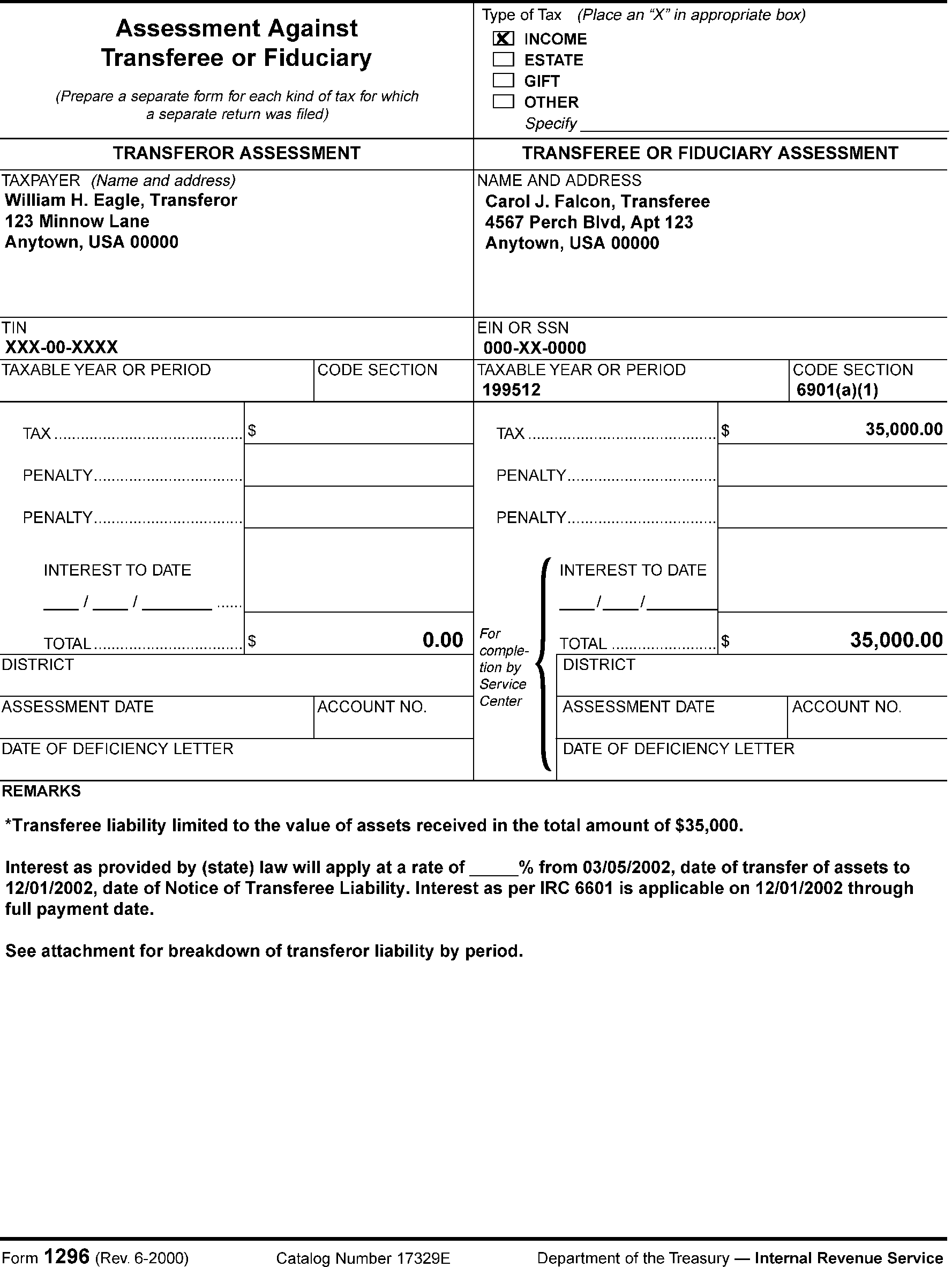

-
The following opening paragraphs are generally used in letters addressed to transferees with respect to their liabilities for an unpaid deficiency of the transferor in income, estate, gift, excise and employment tax cases.
-
Selectable Paragraph 1 - Transferee of assets of transferor (select either income, estate, gift, excise taxes as a result of a liquidation of a corporation, partnership, or reorganization within the meaning of IRC 368(a) , or employment taxes when transferor’s employment tax liability was based on worker classification issues under IRC 7436 ), full or limited liability:
"We determined that you are liable for $X.XX, plus interest as the law provides. This is your liability as transferee of assets of (transferor), (address), for unpaid (select either income, estate, gift, excise, employment) taxes due from (transferor), for the tax year ended December 31, (YYYY) as shown in the enclosed statement." -
Selectable Paragraph 2 - Transferee of assets of first transferee (who received transfer of assets from transferor) (select either income, estate, gift, excise taxes as a result of a liquidation of a corporation, partnership, or reorganization within the meaning of IRC 368(a), or employment taxes when transferor’s employment tax liability was based on worker classification issues under IRC 7436), full or limited liability:
"We determined that you are liable for $X.XX, plus interest as the law provides. This is your liability as transferee of assets of (first transferee),(address), for the unpaid (select either income, estate, gift, excise, employment) taxes due from (transferor) for the tax year ended December 31, (YYYY), as shown in the enclosed statement." -
Selectable Paragraph 3 - Tax liability under 31 USC 3713(b), as fiduciary of (taxpayer) (select either income, estate, gift, excise taxes as a result of a liquidation of a corporation, partnership, or reorganization within the meaning of IRC 368(a), or employment taxes when transferor’s employment tax liability was based on worker classification issues under IRC 7436):
We determined that you are liable for $X.XX, plus interest as the law provides. This is your personal liability under 31 USC 3713(b), as fiduciary of (select either name of taxpayer of income, gift, excise, employment tax, or name of estate), as shown in the enclosed statement.
-
Examples of statements for transferee Notices of Liability most commonly used by Appeals are shown below.
If the value of the assets received by a transferee is less than the unpaid tax liability of the transferor, modify the paragraphs to include the following language:
"Since the value of the assets you received amounted to $___, your liability as transferee is limited to that amount."
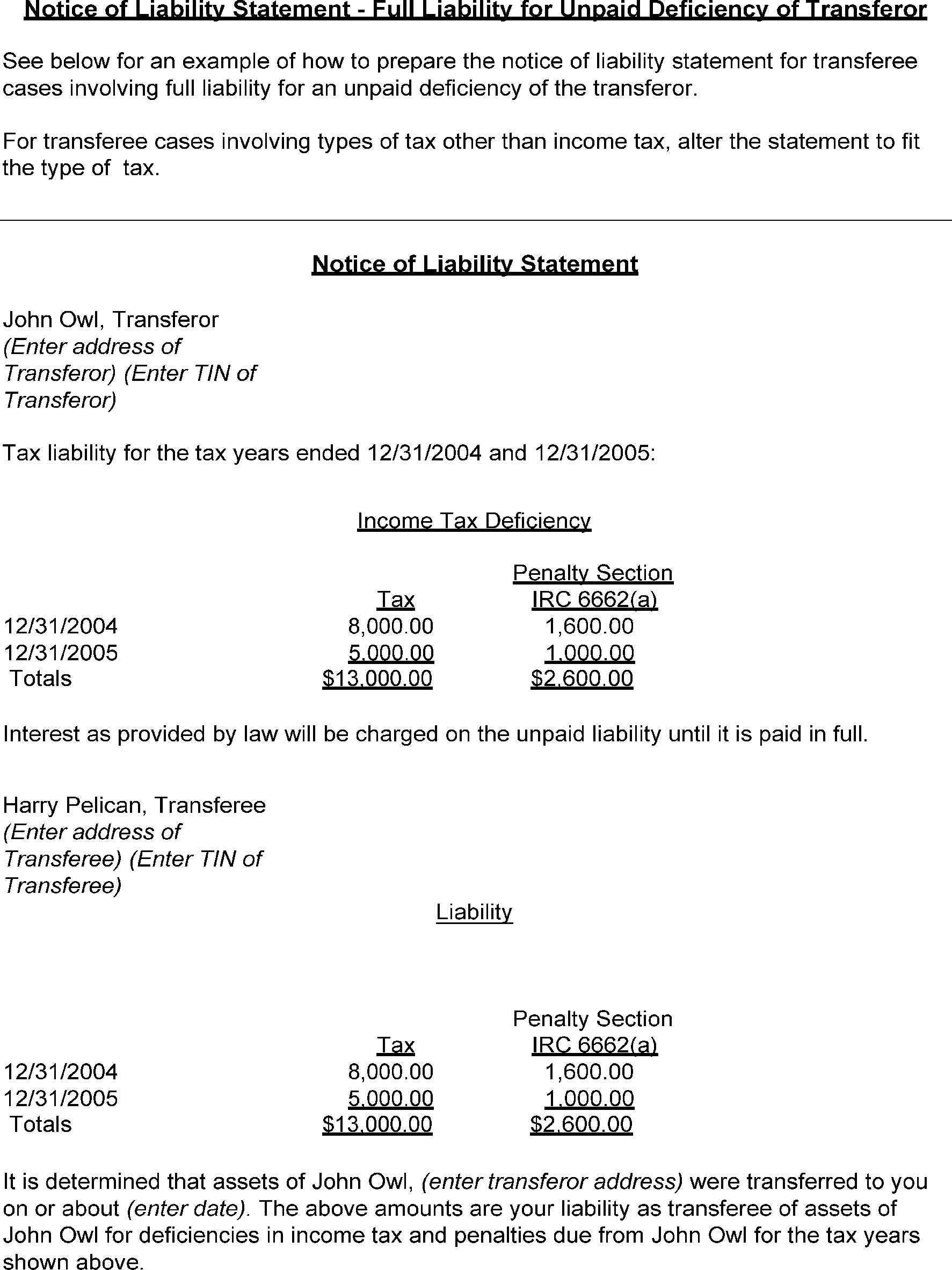
Please click here for the text description of the image.

Please click here for the text description of the image.
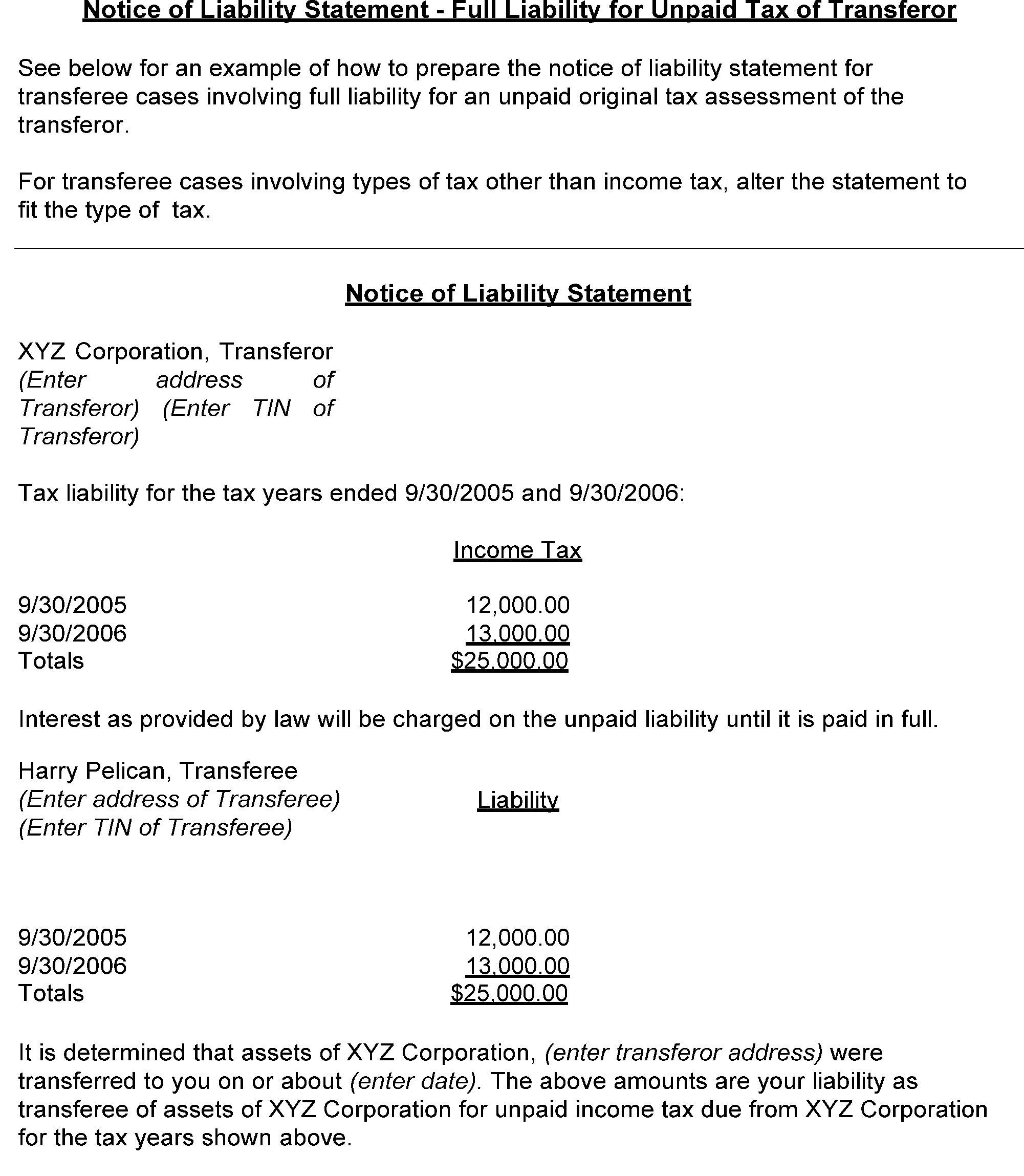
Please click here for the text description of the image.
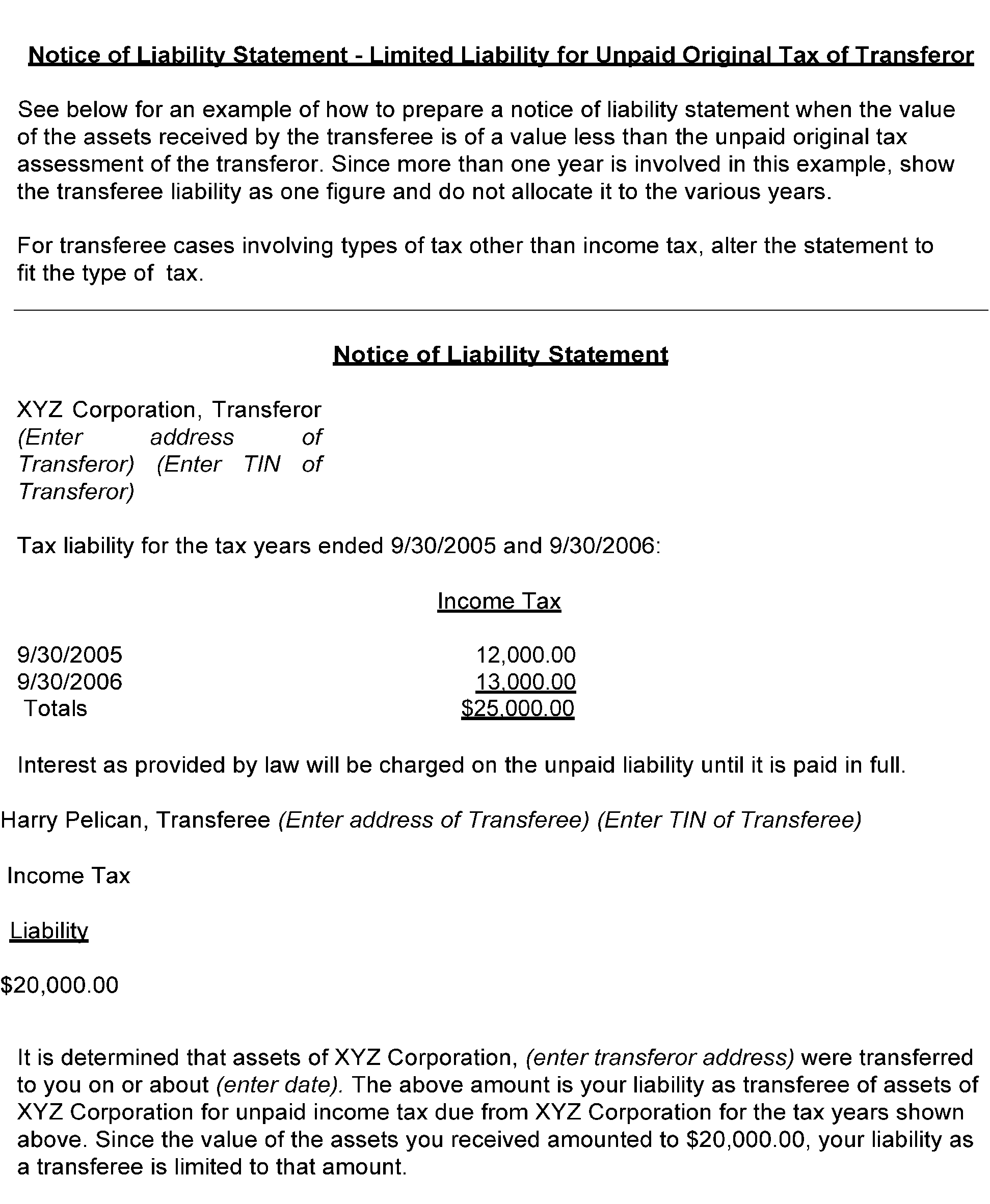
Please click here for the text description of the image.
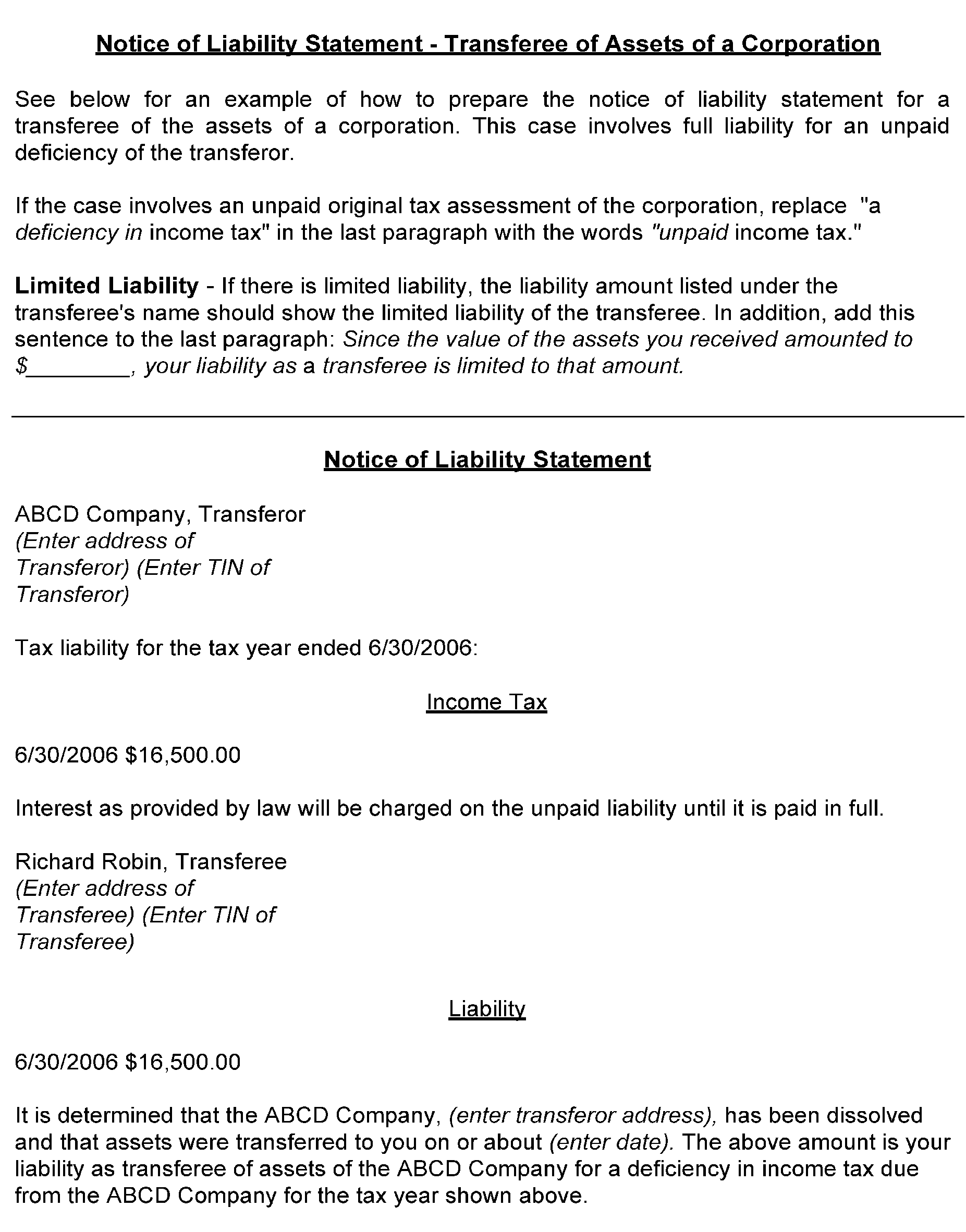
Please click here for the text description of the image.
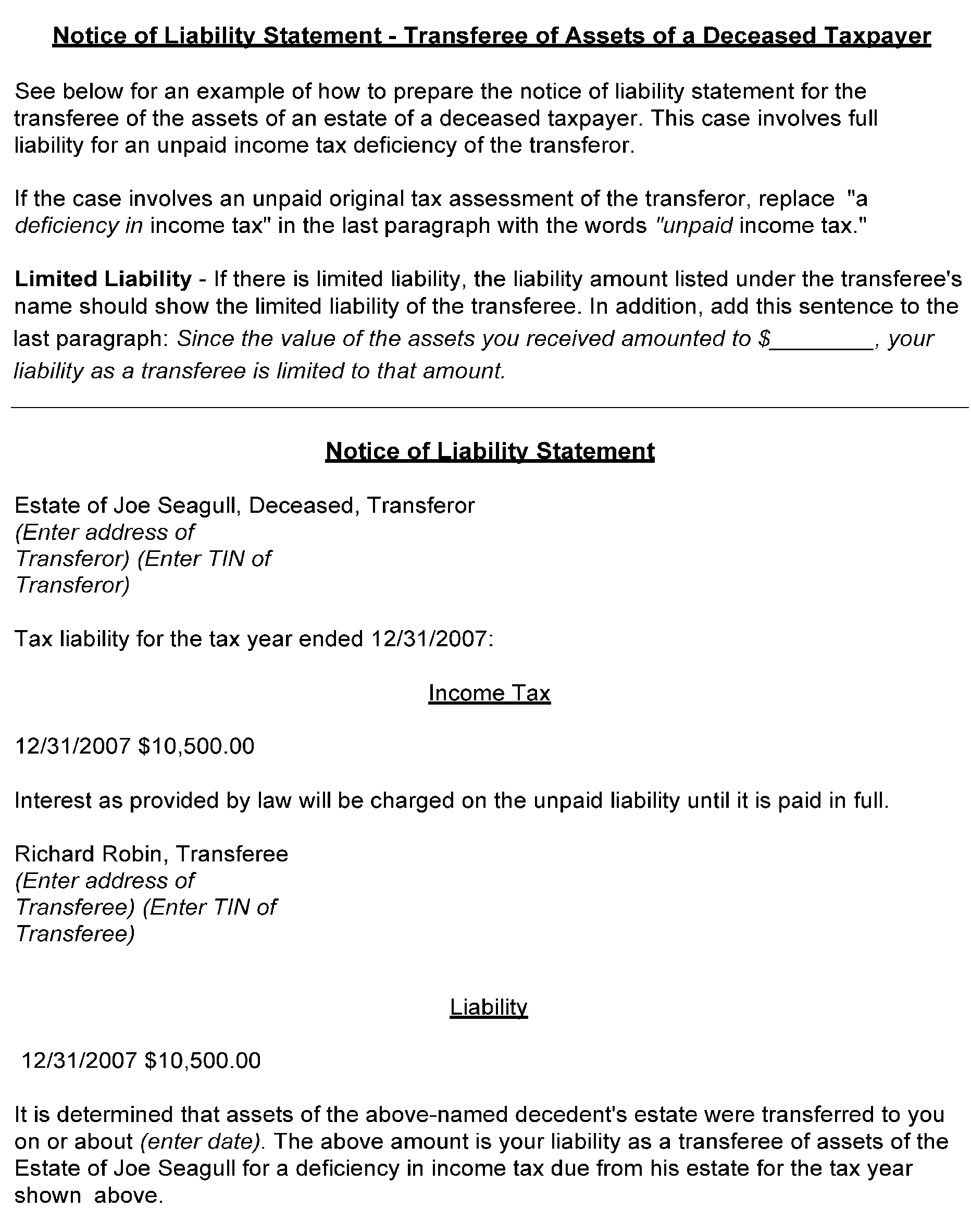
Please click here for the text description of the image.
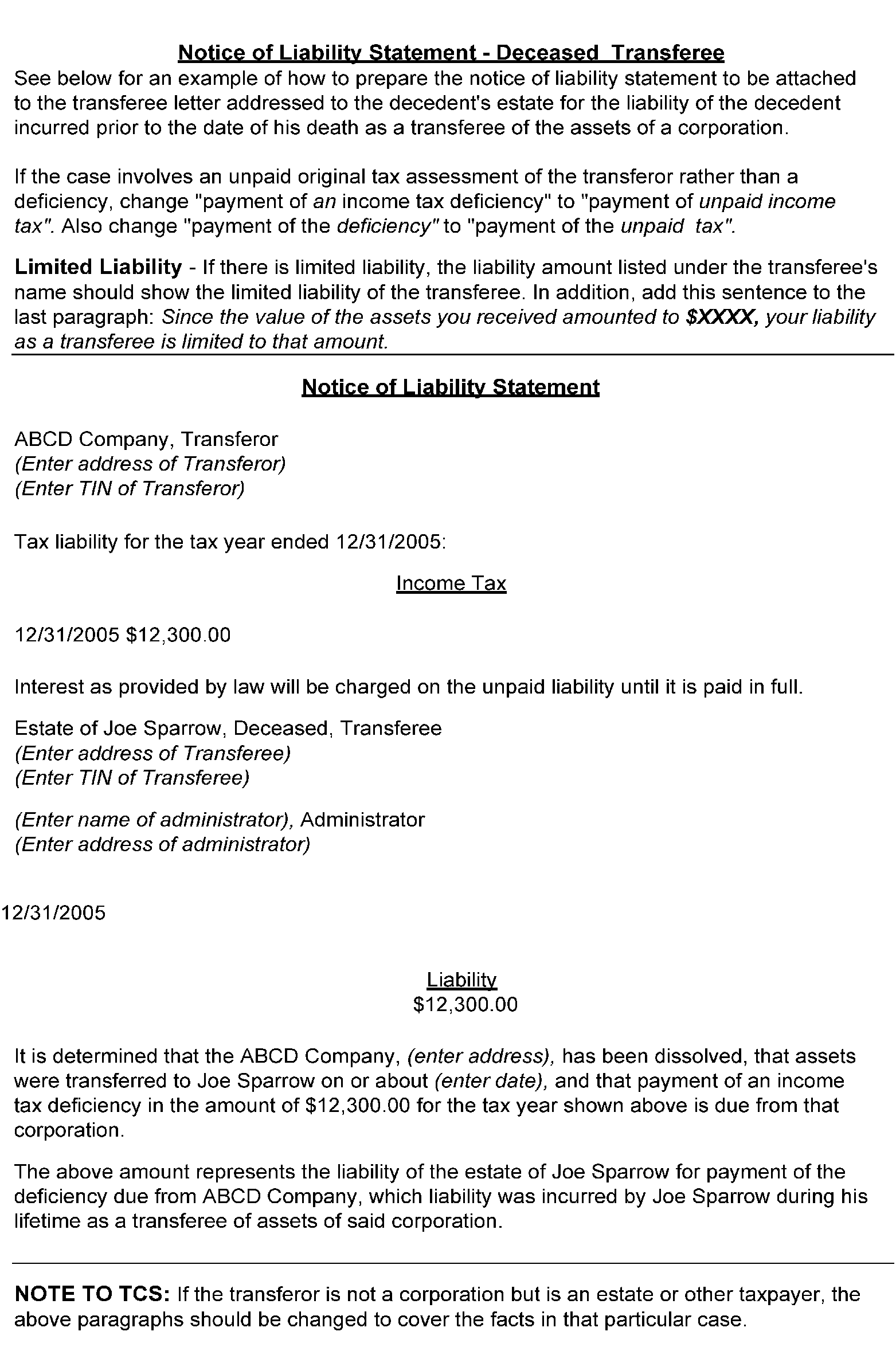
Please click here for the text description of the image.
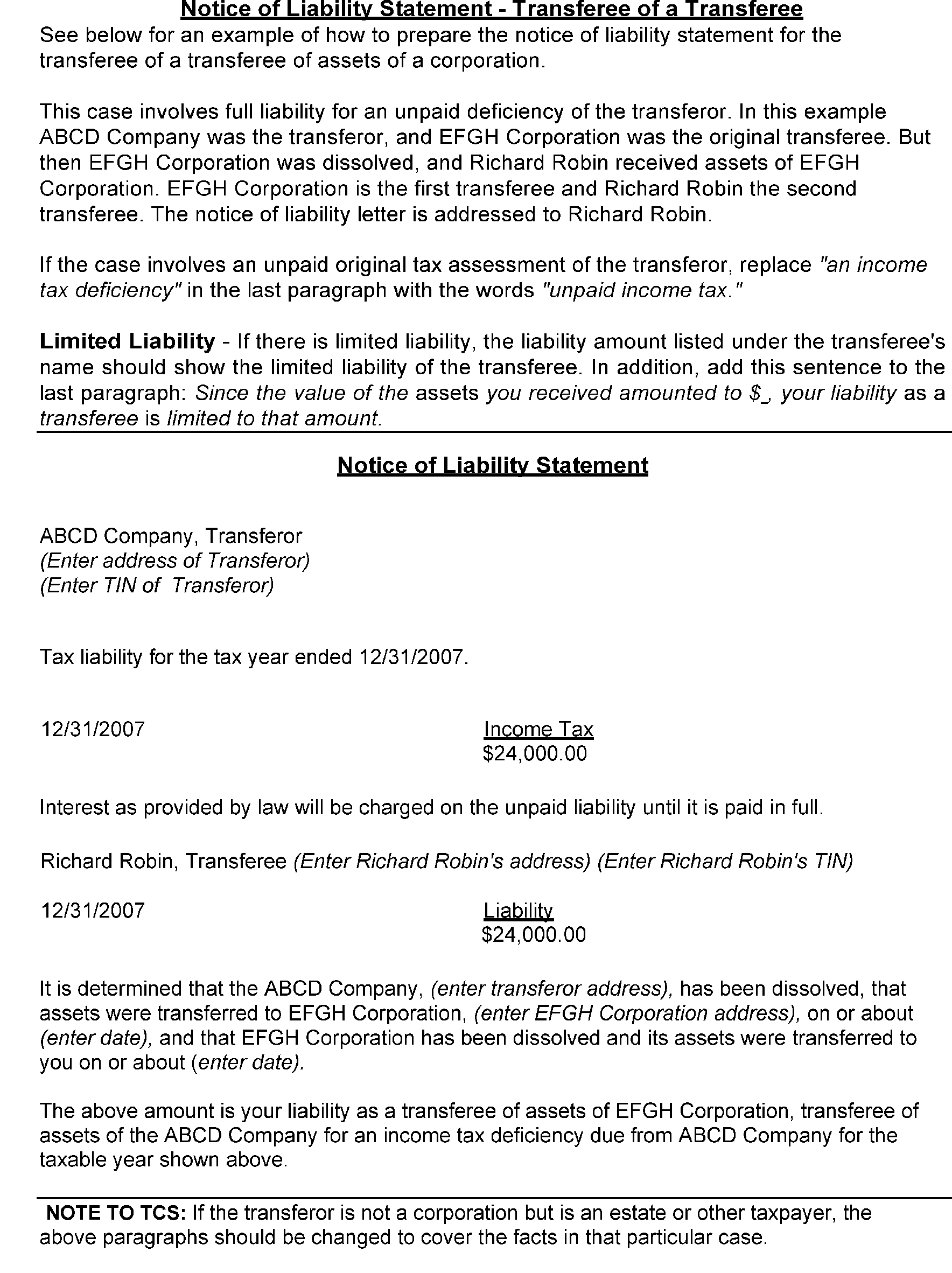
Please click here for the text description of the image.
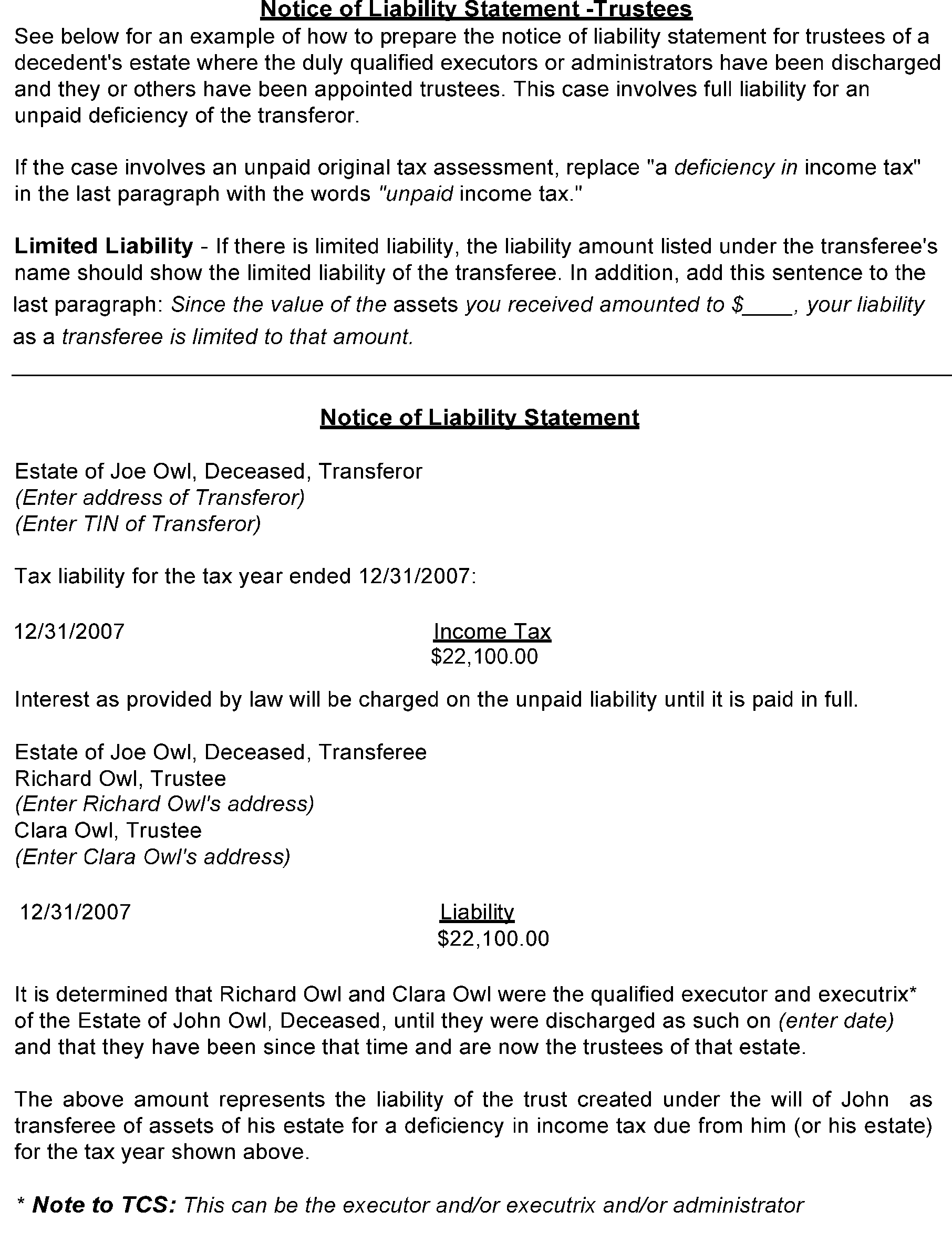
Please click here for the text description of the image.
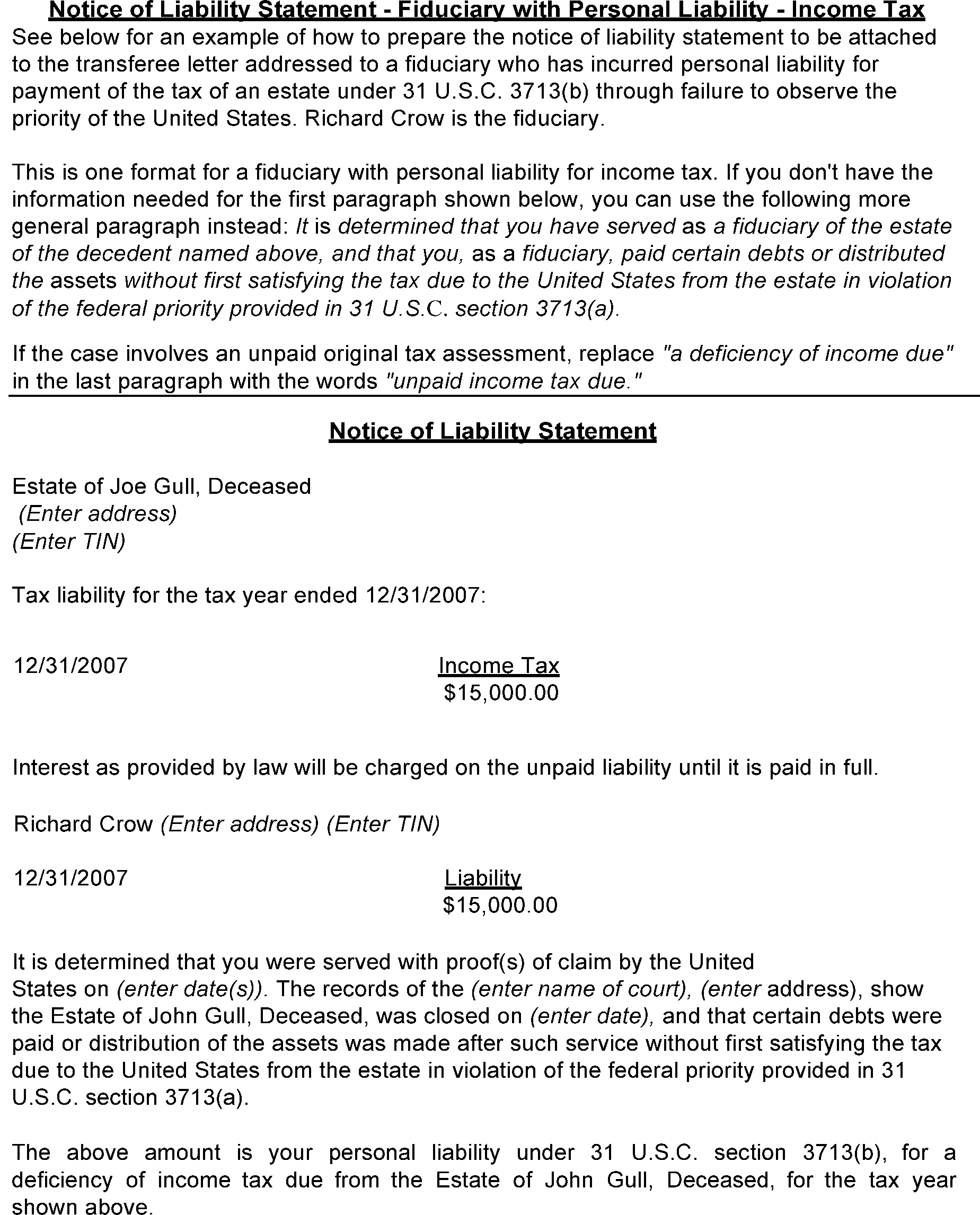
Please click here for the text description of the image.
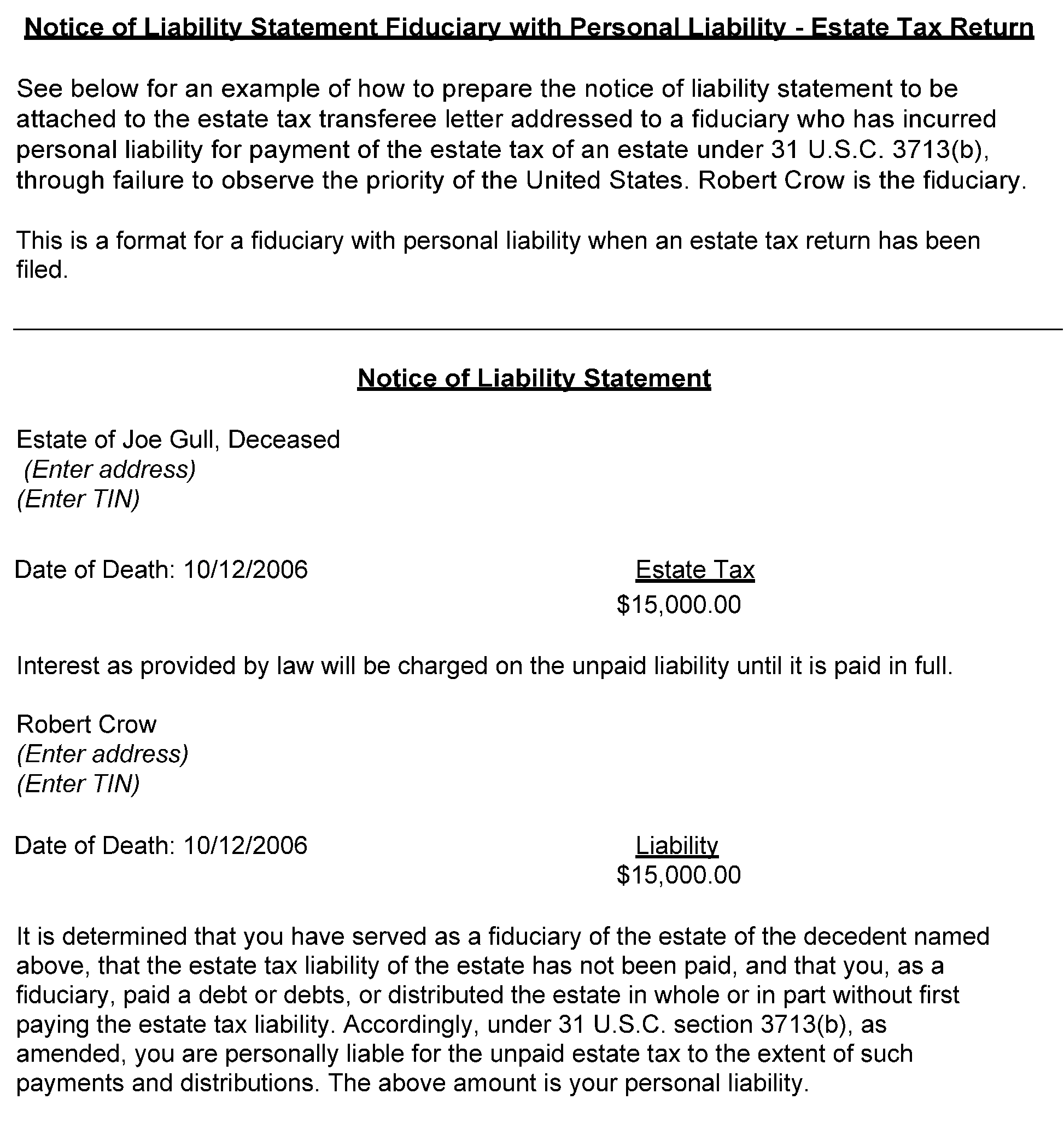
Please click here for the text description of the image.
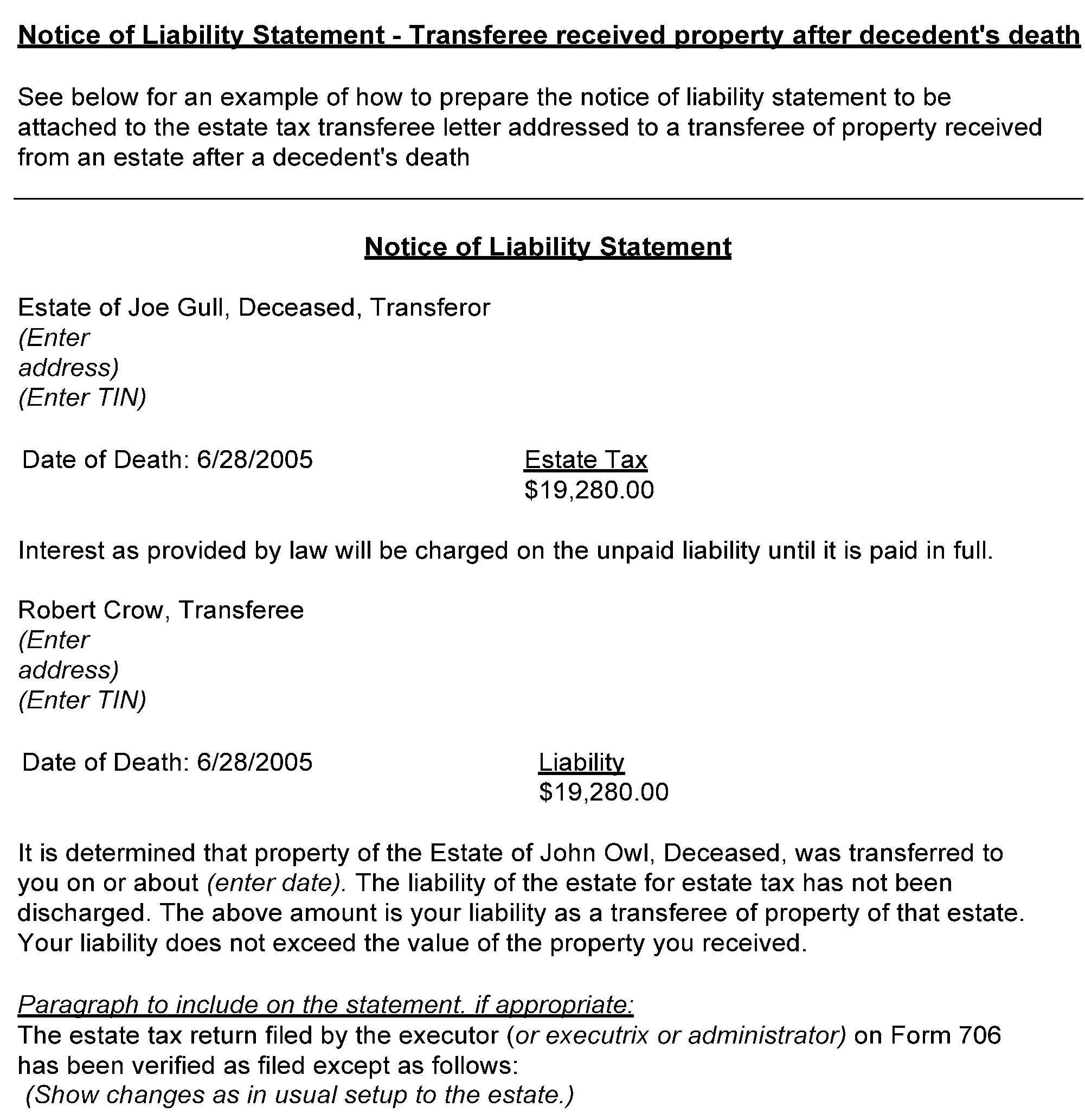
Please click here for the text description of the image.

Please click here for the text description of the image.
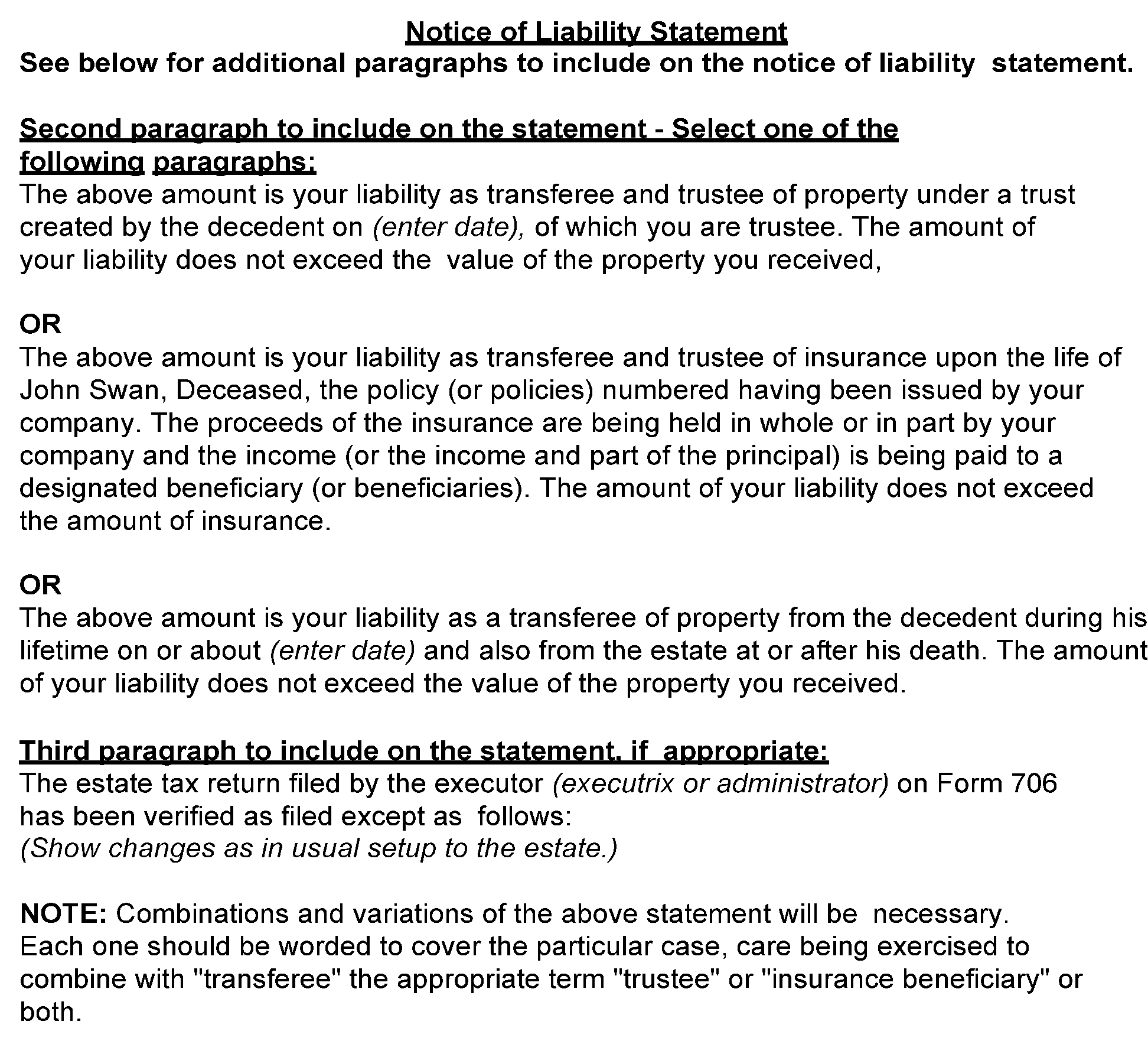
Please click here for the text description of the image.
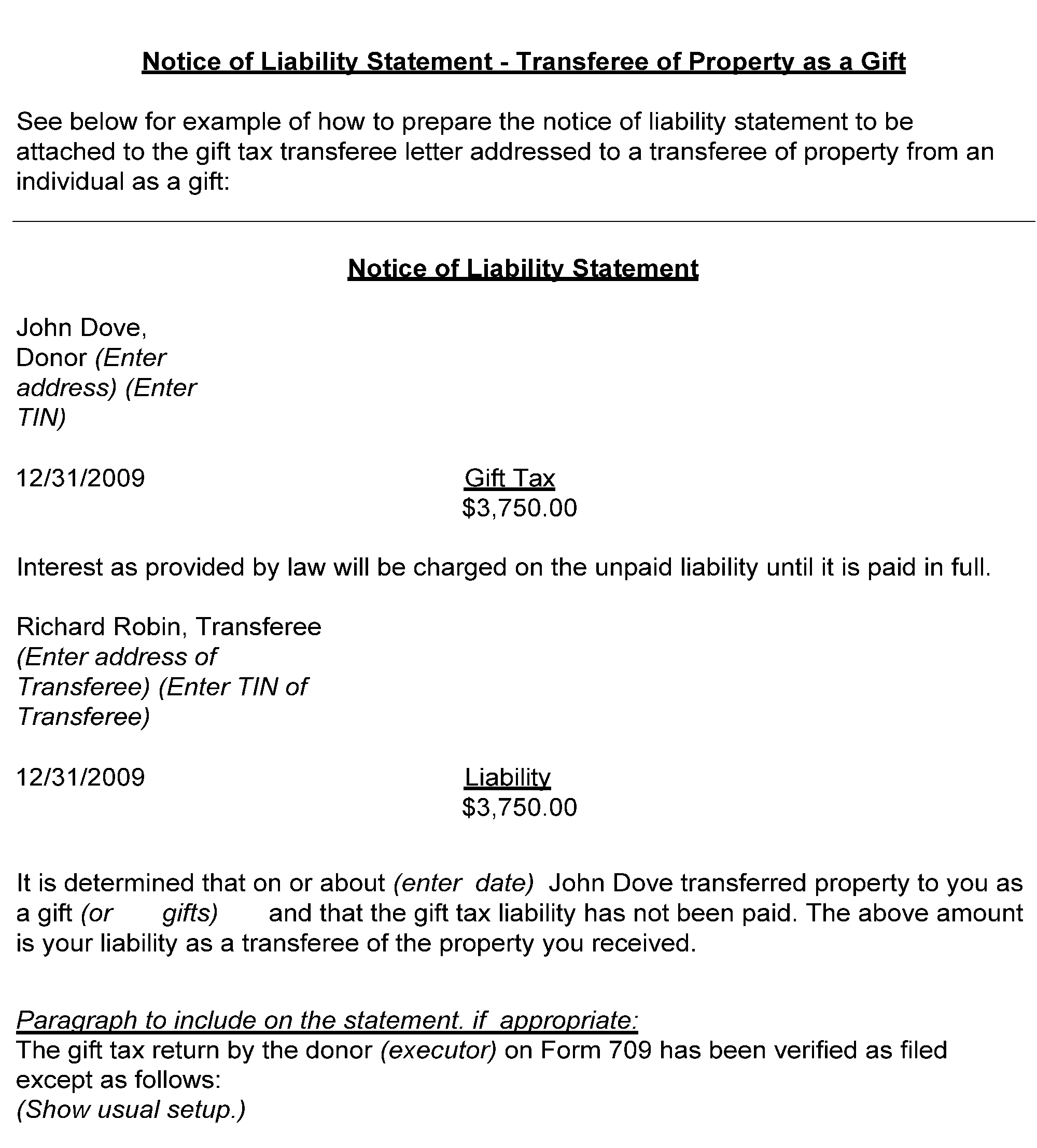
Please click here for the text description of the image.

Please click here for the text description of the image.
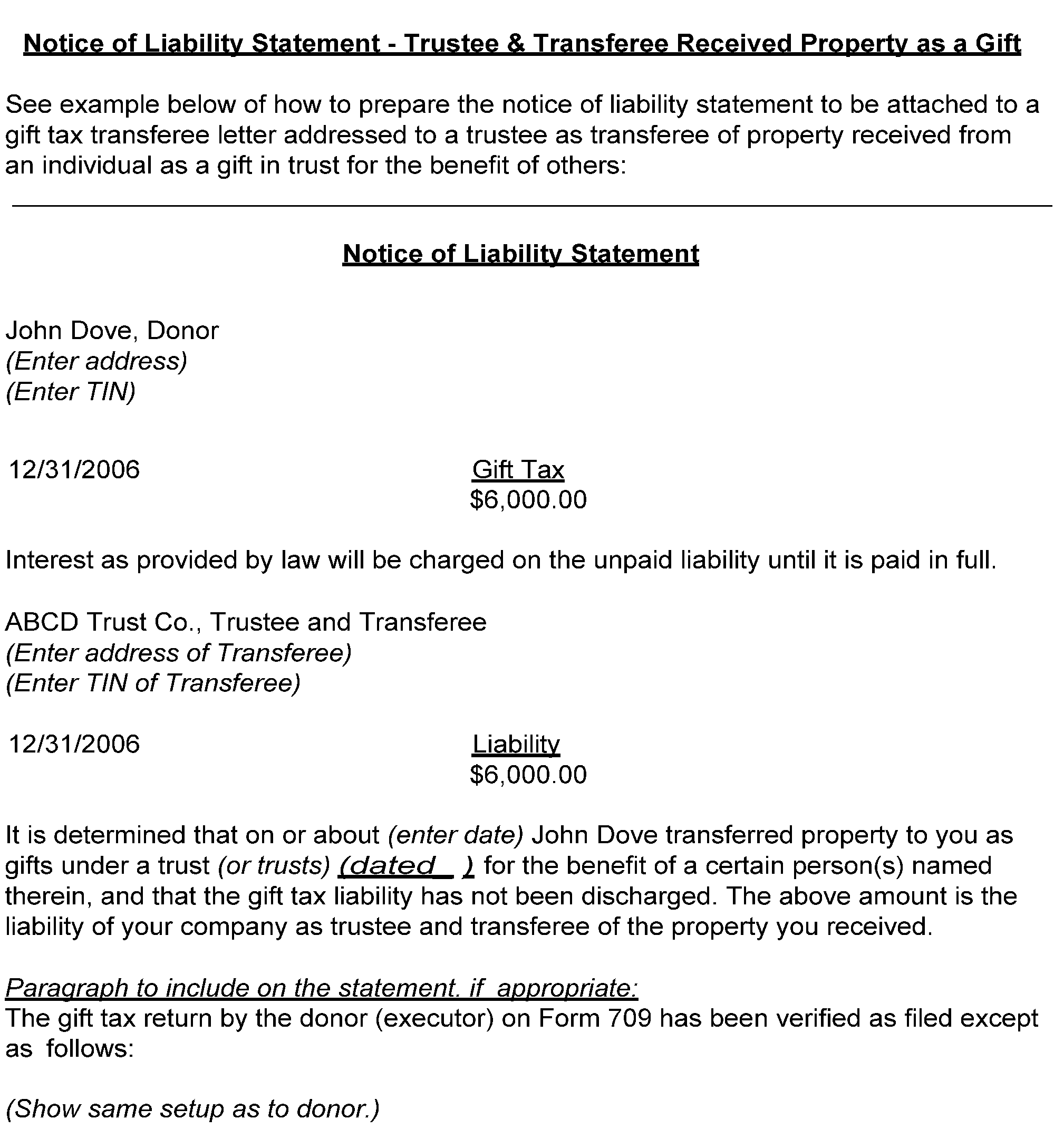
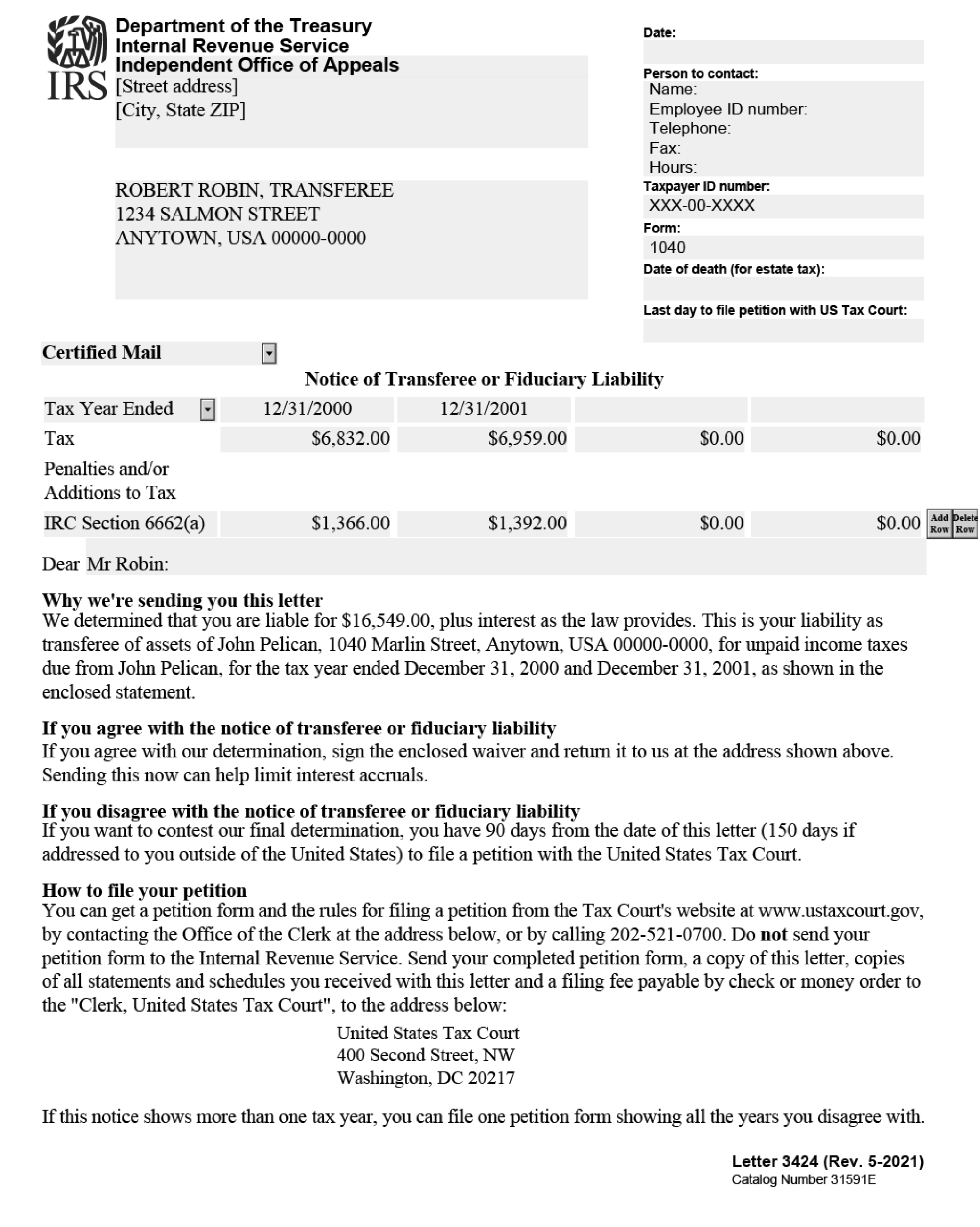
Please click here for the text description of the image.
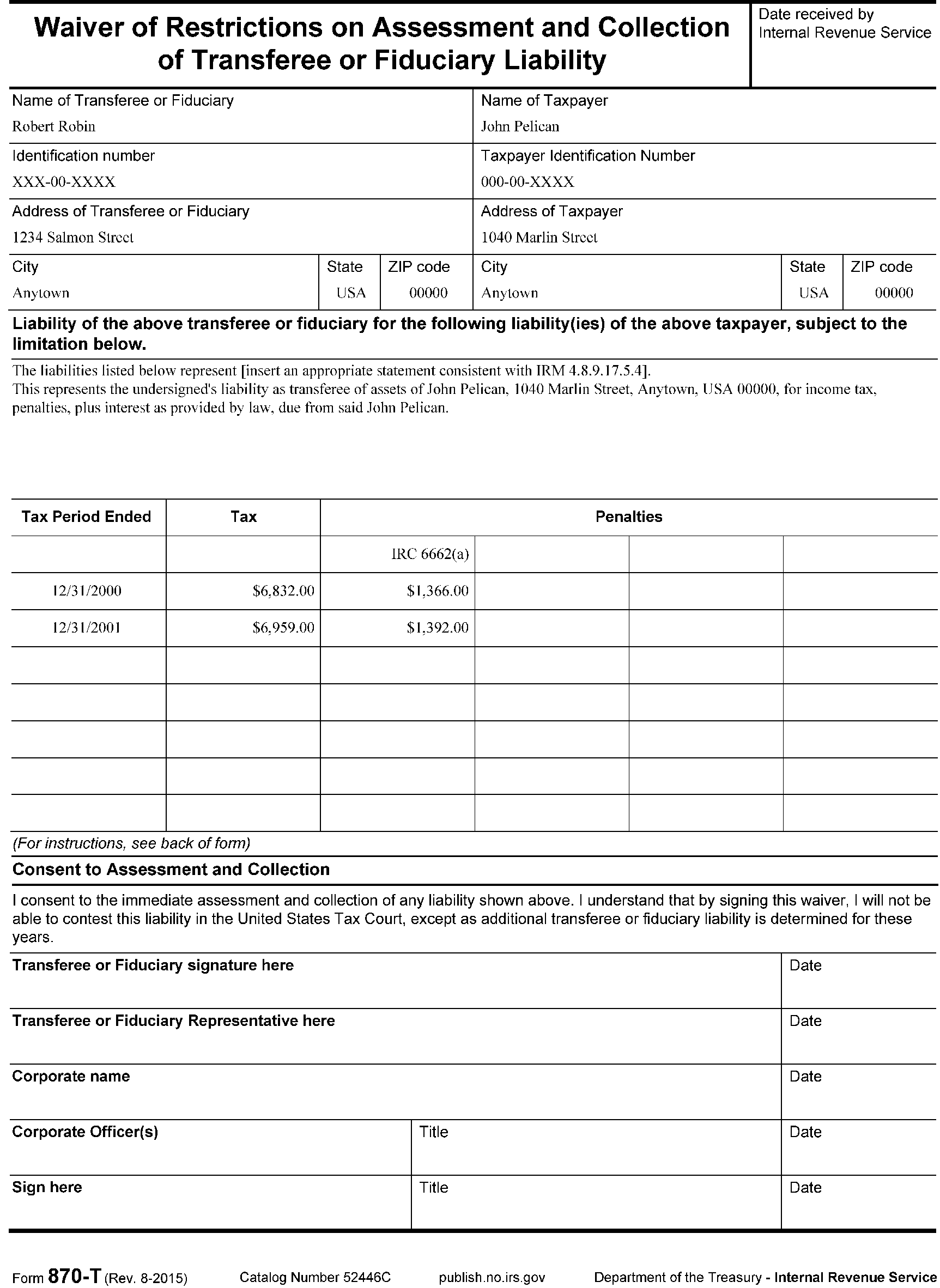
Please click here for the text description of the image.
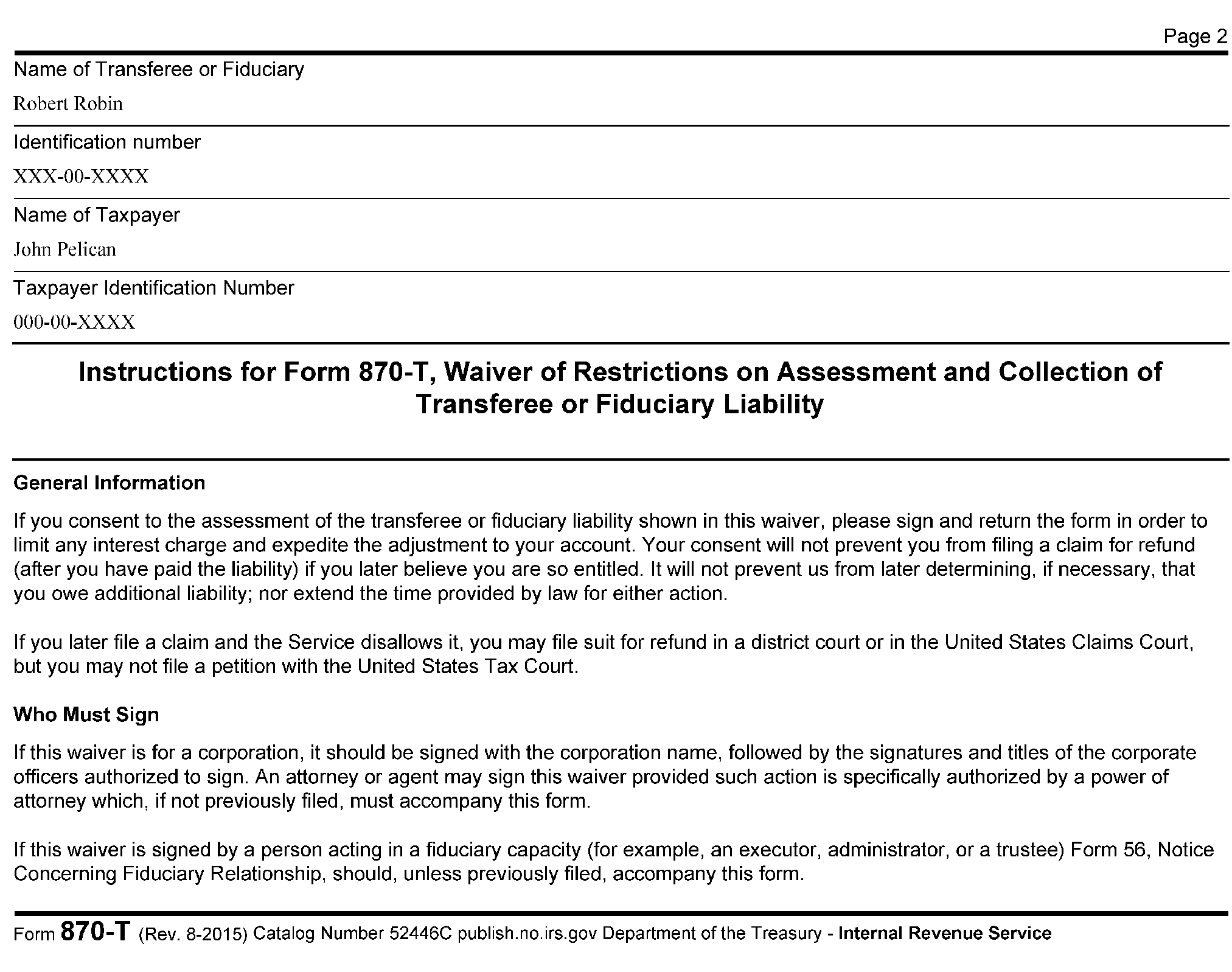
Please click here for the text description of the image.
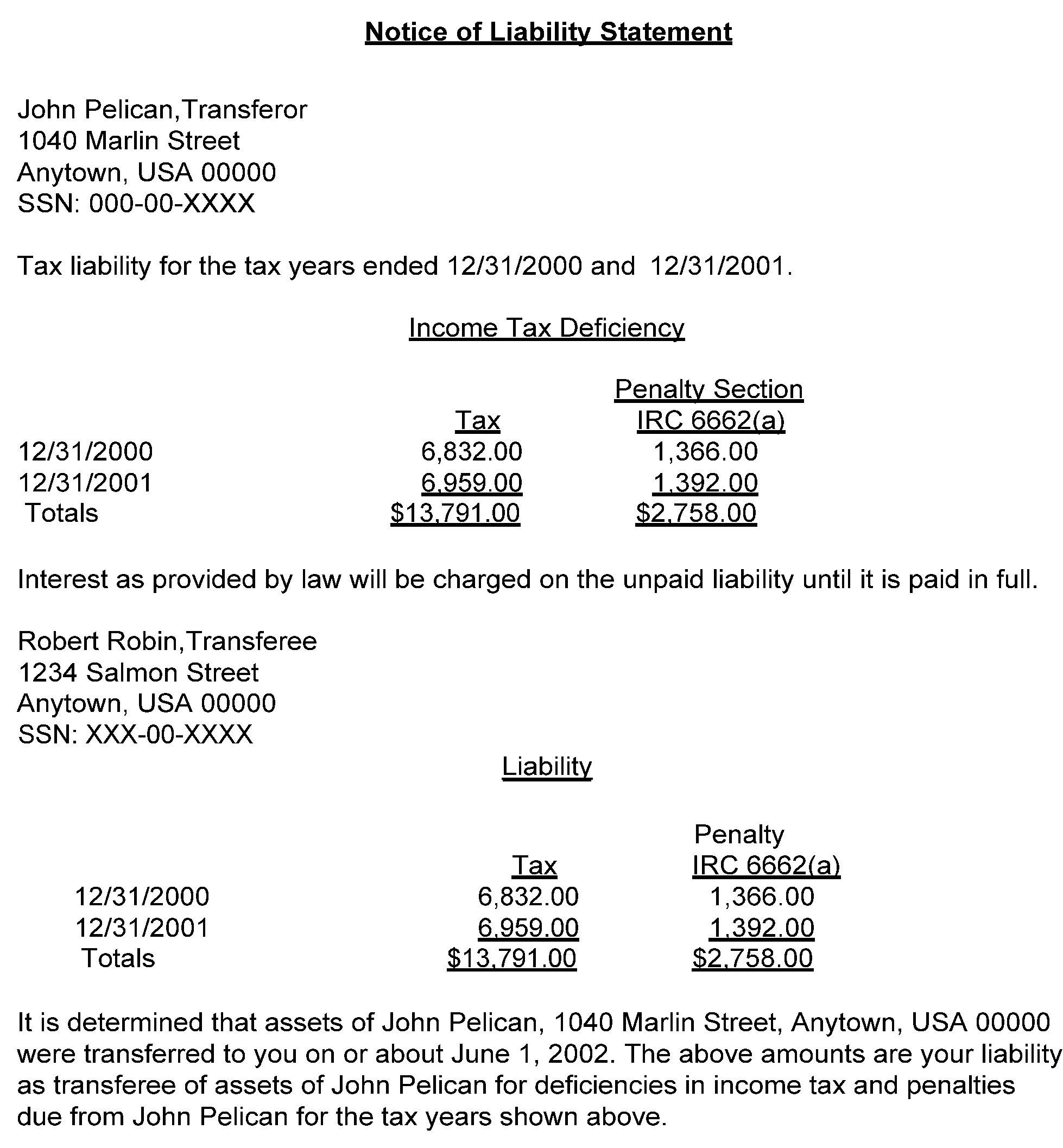
Please click here for the text description of the image.
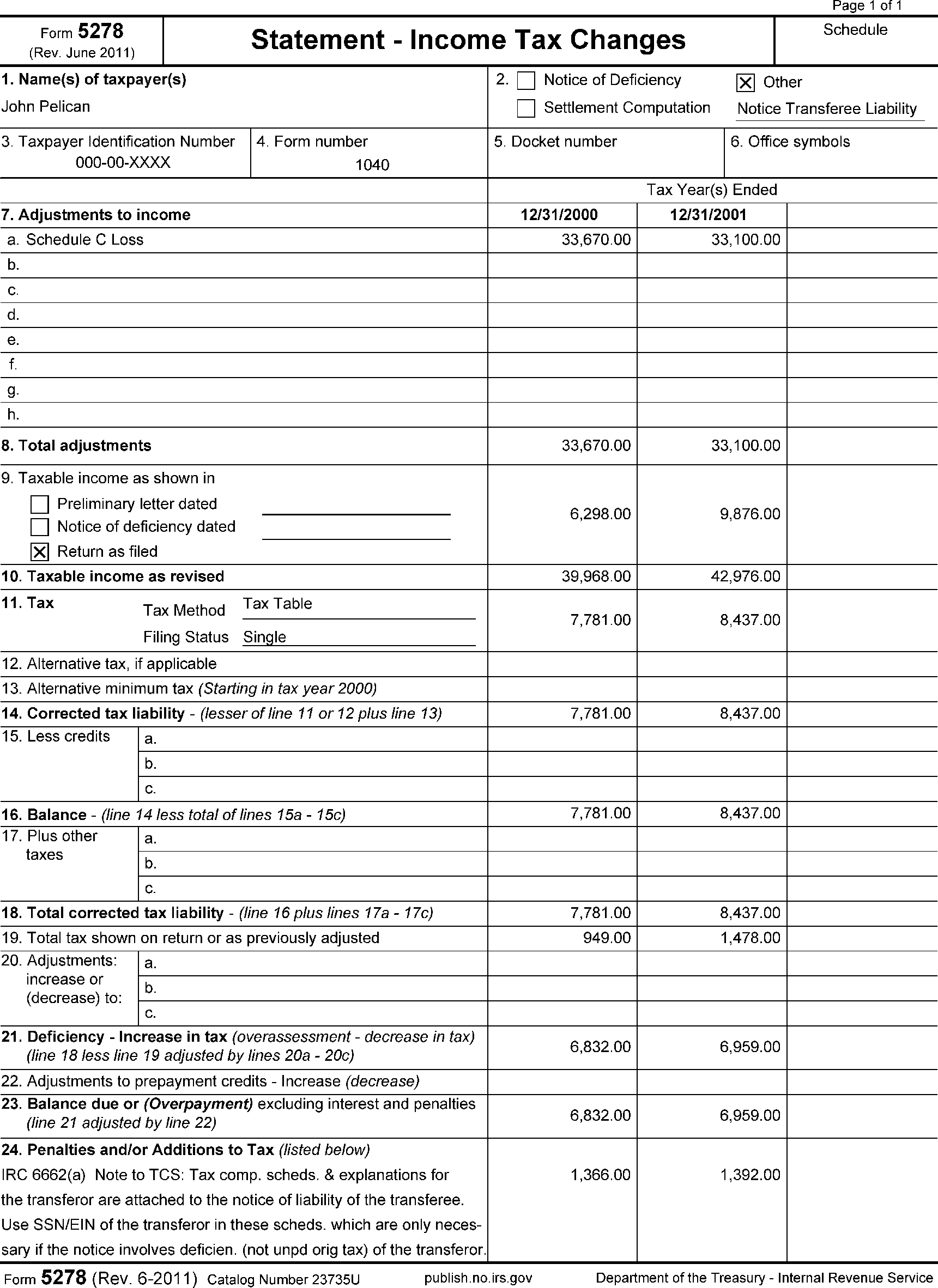
Please click here for the text description of the image.
Explanation of Adjustment for Full Liability Transferee Notice (Cont)
| John Pelican, Transferor | Schedule 2 |
| Explanation of Adjustments | |
| a) Schedule C Loss | |
| It is determined that the amounts of $33,670.00 for tax year ended December 31, 2000 and $33,100.00 for tax year ended December 31, 2001, claimed as losses from horse racing are not allowed. It has not been established that the losses from such activity constitute a bona fide business venture entered into for profit. Further, it has not been established that the claimed expenses were incurred or, if incurred, paid by you during the taxable years for ordinary and necessary business expenses, or that any claimed amount qualifies as a deduction under the provisions of the Internal Revenue Code. Accordingly, your taxable income is increased $33,670.00 and $33,100.00 for the taxable years 2000 and 2001, respectively. | |
| Note to preparer of this Explanation of Adjustment schedule: Schedule 3 is not included in this exhibit. Schedule 3 is the RGS or Excel penalty computation. | |

 )
hoặc https:// có nghĩa là bạn đã kết nối an toàn với trang web .gov. Chỉ chia sẻ thông tin nhạy cảm trên các trang web chính thức, an toàn.
)
hoặc https:// có nghĩa là bạn đã kết nối an toàn với trang web .gov. Chỉ chia sẻ thông tin nhạy cảm trên các trang web chính thức, an toàn.


